Had a reasonable start in Zagora this morning, but by the time we went to a supermarket to pick up some picnic supplies, and some more wine, it felt like we were getting a bit of a late start. Zagora has this thing about being 52 days walk from Timbucktoo – spelt here as Tomboutouc, so we had to stop at the famous sign that shows you are in fact, 52 days walk from Timbucktoo..?! No idea why, but when the Chinese tourists finally got out of the way we took a photo.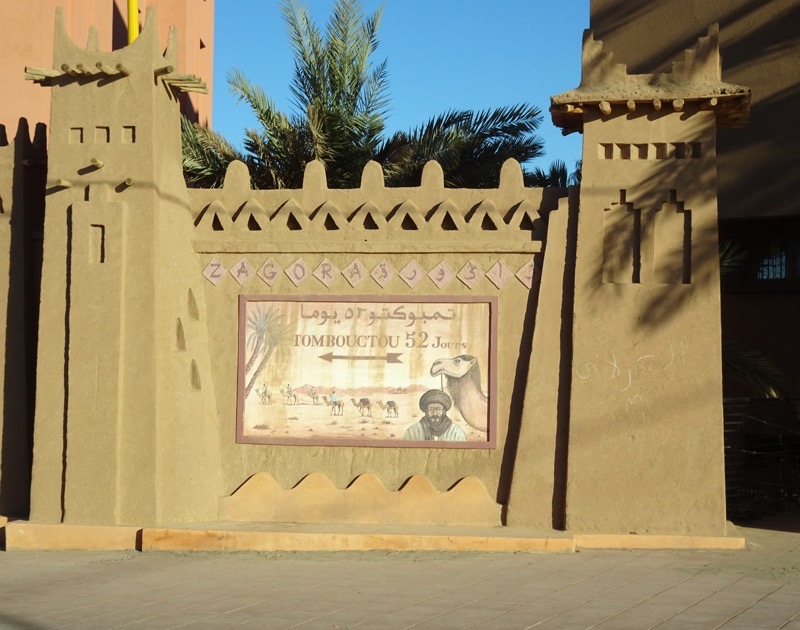 Our first stop this morning was the small town of Tamegroute. Tamoutgroute is a famous zawiya (religious learning institute) which houses thousands of manuscripts, and at once time was the largest and richest library of North Africa. There is a very nice collection of some 4200, some of which are still on display in the zawiya. You can go in, but there is no photography allowed. Among the manuscrispts is a rare 14th-century Quran with beautiful calligraphy in Kufic script. The library also contains writings on theorlogy, astronomy, georgraphy, sciences, mathenatics and traslations of ancient Greek philosophers and mathematicans. The collection started in the 16thC by a man named Ahmad bin Nasi, and was transferred to the zawiya on his death Also in the zawiya complex is the mausoleum of several prominent sheiks and religious leaders since that time, and a hospital for the mentally ill, as Ahmad bin Nasi had a particular interest in mental illness.
Our first stop this morning was the small town of Tamegroute. Tamoutgroute is a famous zawiya (religious learning institute) which houses thousands of manuscripts, and at once time was the largest and richest library of North Africa. There is a very nice collection of some 4200, some of which are still on display in the zawiya. You can go in, but there is no photography allowed. Among the manuscrispts is a rare 14th-century Quran with beautiful calligraphy in Kufic script. The library also contains writings on theorlogy, astronomy, georgraphy, sciences, mathenatics and traslations of ancient Greek philosophers and mathematicans. The collection started in the 16thC by a man named Ahmad bin Nasi, and was transferred to the zawiya on his death Also in the zawiya complex is the mausoleum of several prominent sheiks and religious leaders since that time, and a hospital for the mentally ill, as Ahmad bin Nasi had a particular interest in mental illness. Outside the library.
Outside the library. A picture shamelessly stolen from the internet of the old manuscripts kept in the library.
A picture shamelessly stolen from the internet of the old manuscripts kept in the library.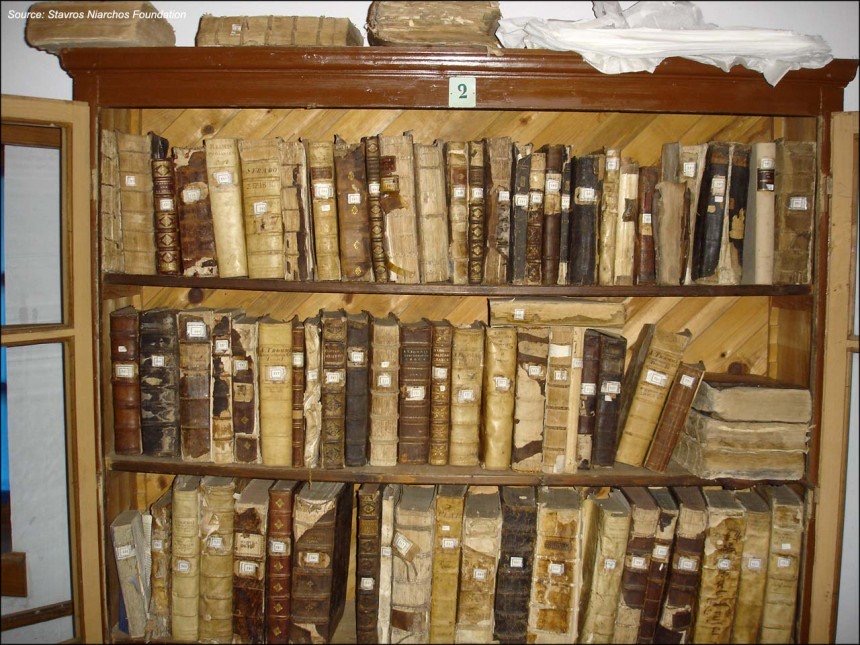 The zawiya’s mosque – and of course fountains for ablutions.
The zawiya’s mosque – and of course fountains for ablutions.
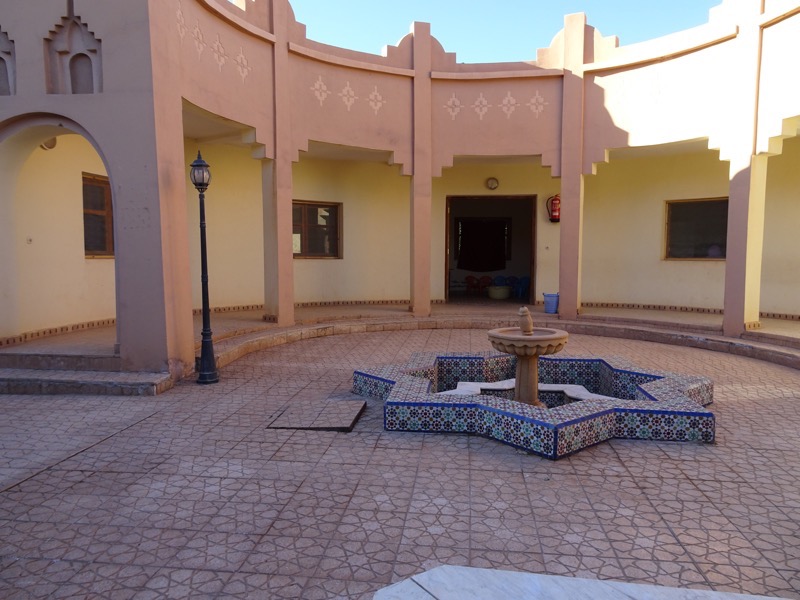 And the door to the aforementioned hospice for the mentally ill and our guide, Mohammed, showing us the door handles..
And the door to the aforementioned hospice for the mentally ill and our guide, Mohammed, showing us the door handles.. 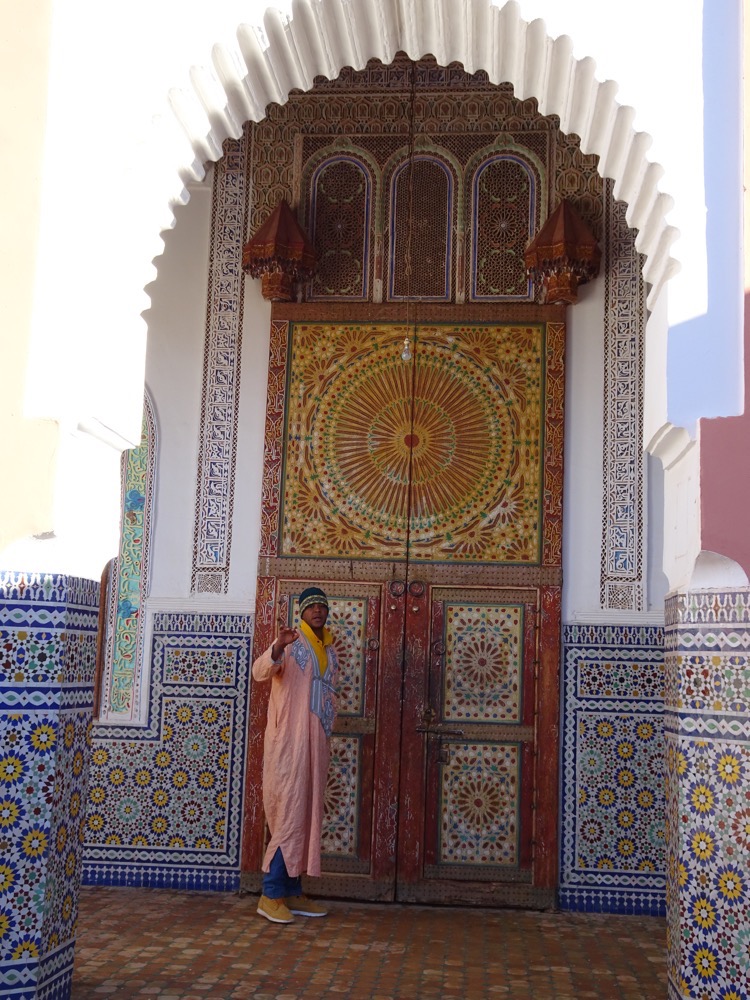 The door to the asylum has four door-knockers – the top right for men, the top left for women, the bottom left for children and the bottom right for people wanting good wishes. If Mohammed explained why this was the case – I missed it in amongst his extremely thick accent. I love the intricated mosaic, carving and painted work on the buildings here.
The door to the asylum has four door-knockers – the top right for men, the top left for women, the bottom left for children and the bottom right for people wanting good wishes. If Mohammed explained why this was the case – I missed it in amongst his extremely thick accent. I love the intricated mosaic, carving and painted work on the buildings here.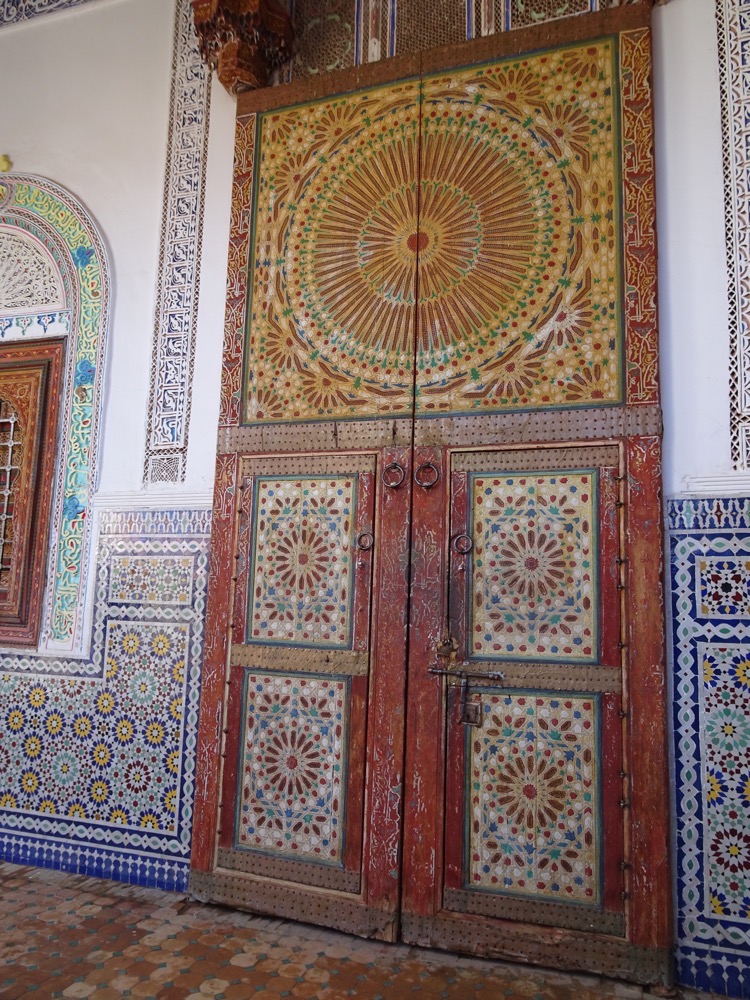
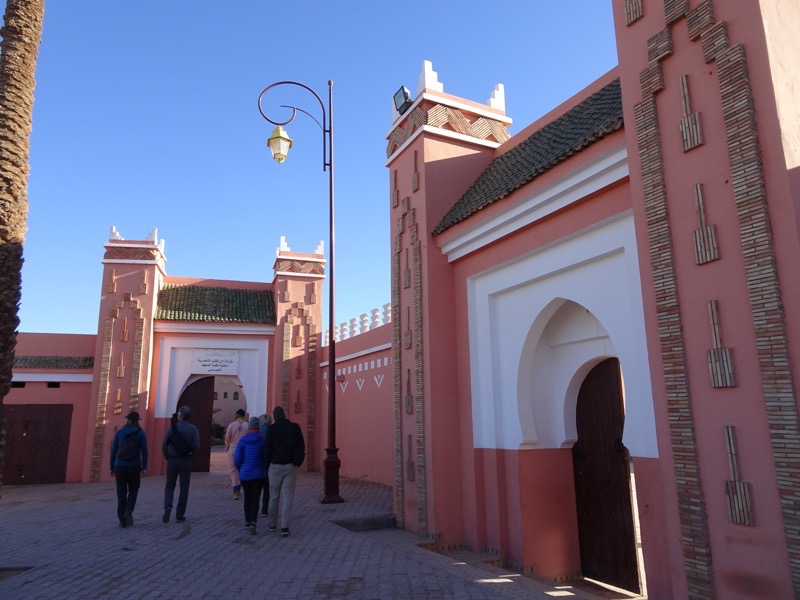
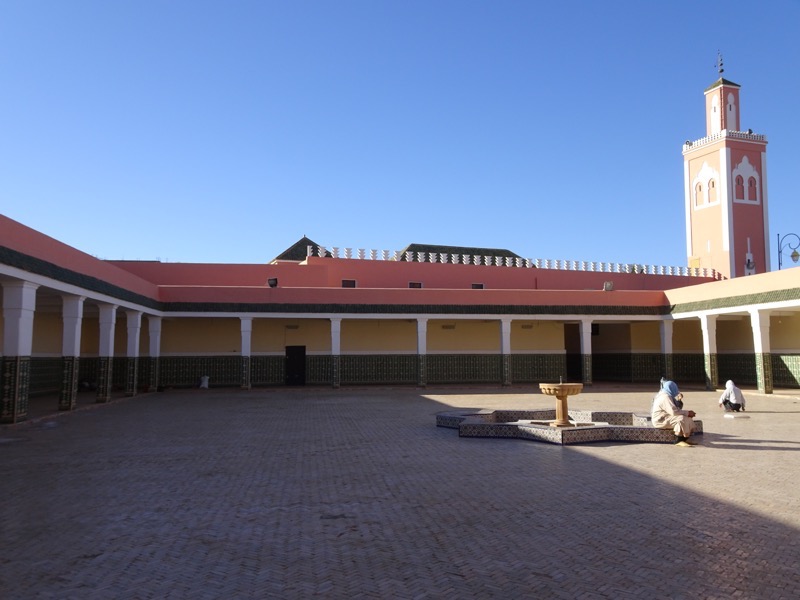 Further around from the zawiya, is the Tamagroute underground kasbah. The people here would take refuge from invading nomads and bedouins in the event of an attack on their granaries or resources. It was a particularly dark, narrow and kinda dismal kasbah, which still housed many people. At irregular intervals, there was light penetrating the dark alleyways, which served no other purpose than to blind you when you plunged back into the dark again.
Further around from the zawiya, is the Tamagroute underground kasbah. The people here would take refuge from invading nomads and bedouins in the event of an attack on their granaries or resources. It was a particularly dark, narrow and kinda dismal kasbah, which still housed many people. At irregular intervals, there was light penetrating the dark alleyways, which served no other purpose than to blind you when you plunged back into the dark again.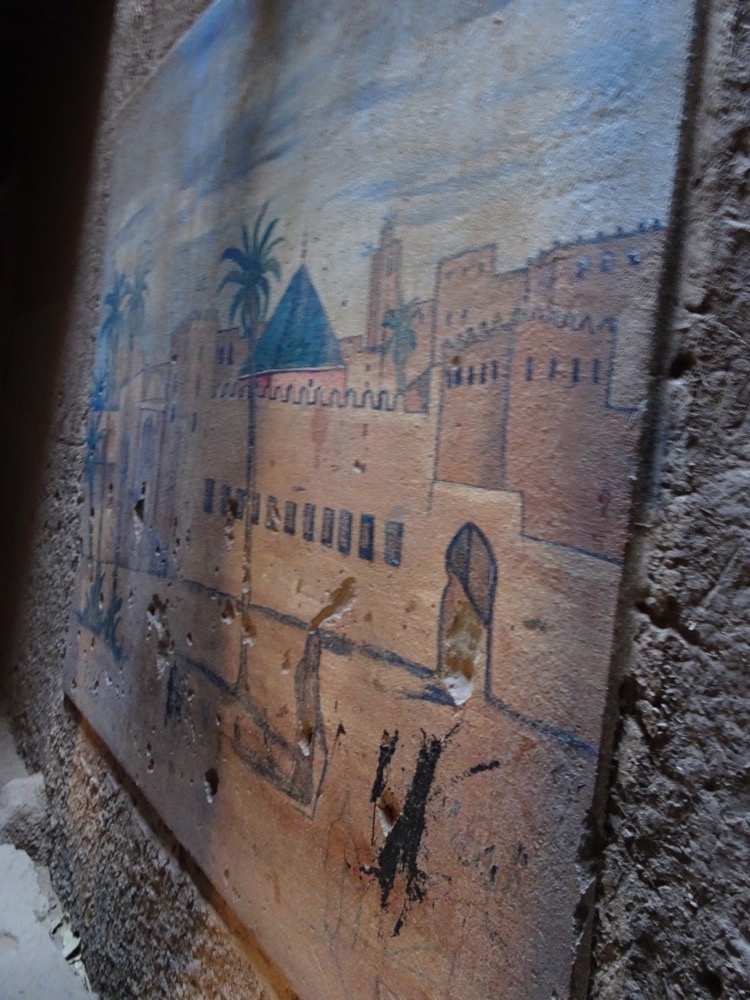
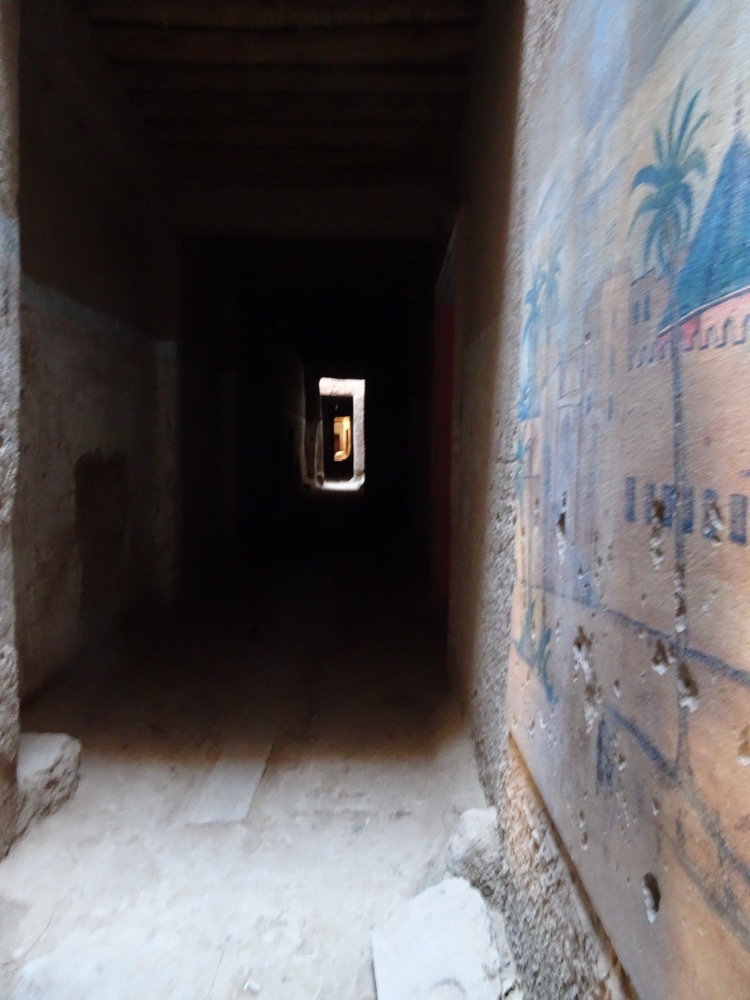
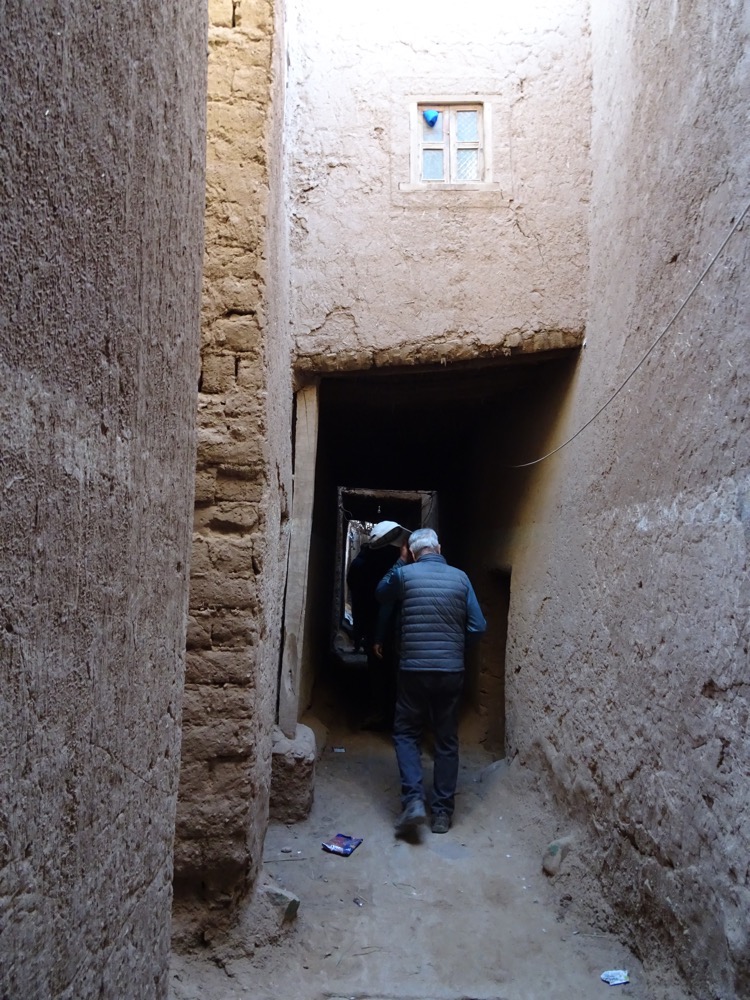
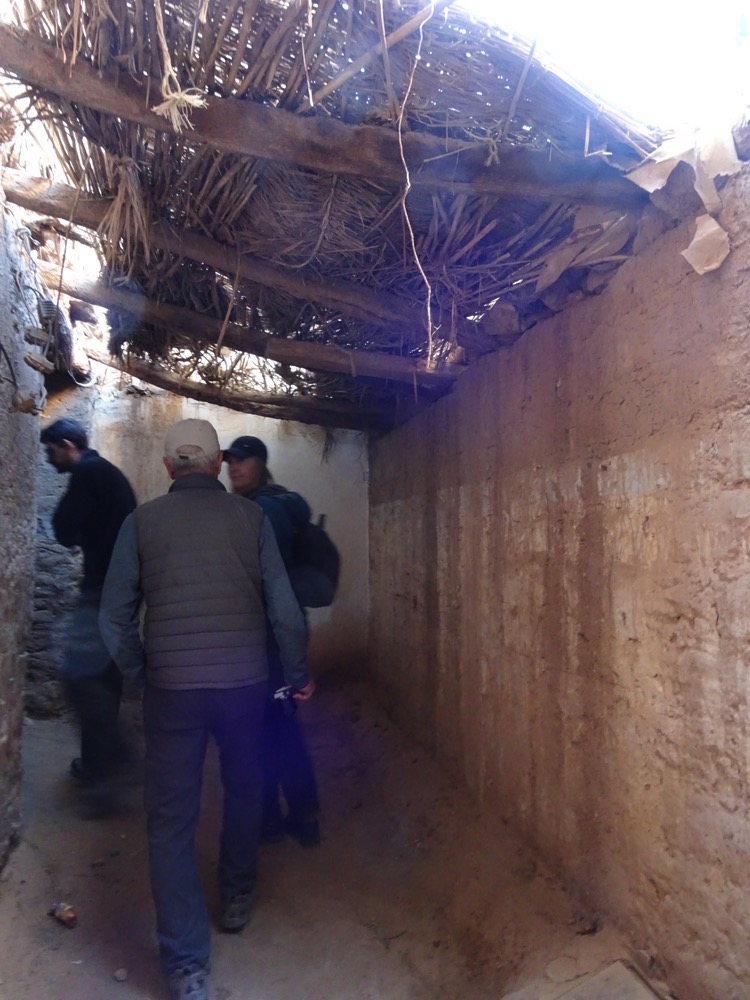 Quite a significant portion of the kasbah was in serious disrepair. It certainly gives a different perspective on things back home – we need to finally fucking fix our back fence, but every single time I travel to a country where people are living in houses with massive holes in them, or tarpaulins for a roof or maybe holes gaping like this in the wall – I kinda go, ‘Meh, the back fence can wait, it’s not that bad’. Not overly helpful on the home maintenance front but the more I travel the less I care about the little things about the house that aren’t perfect.
Quite a significant portion of the kasbah was in serious disrepair. It certainly gives a different perspective on things back home – we need to finally fucking fix our back fence, but every single time I travel to a country where people are living in houses with massive holes in them, or tarpaulins for a roof or maybe holes gaping like this in the wall – I kinda go, ‘Meh, the back fence can wait, it’s not that bad’. Not overly helpful on the home maintenance front but the more I travel the less I care about the little things about the house that aren’t perfect.
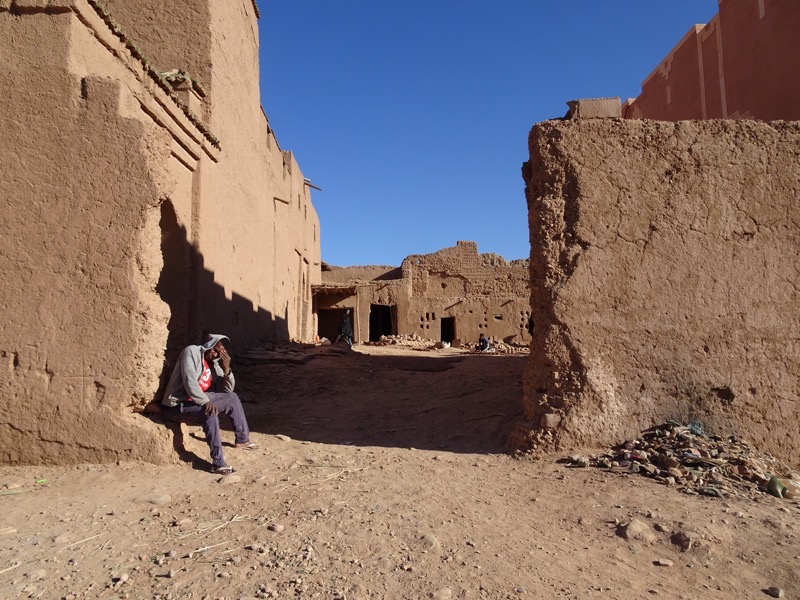
Not far from the underground kasbah is Tamegroute’s famous green ceramics production centre. This ceramics post creates all their wares with natural dyes and paints only. 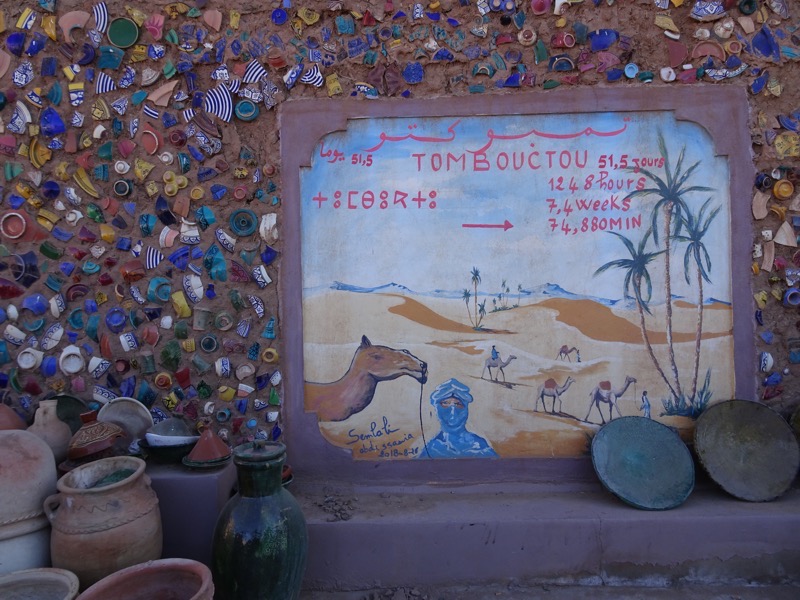

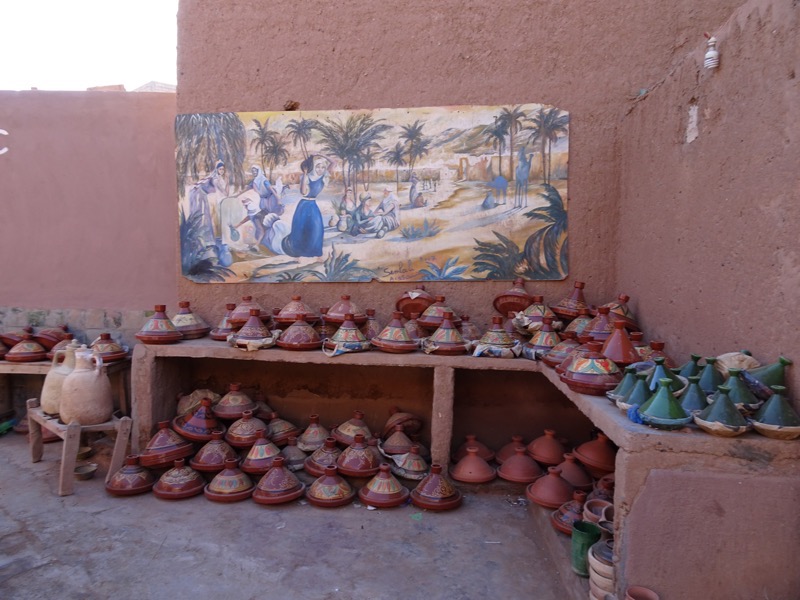 The red comes from henna, the blue from indigo, the yellow from tumeric and saffron and the distinctive green comes from various local plants in the region.
The red comes from henna, the blue from indigo, the yellow from tumeric and saffron and the distinctive green comes from various local plants in the region.
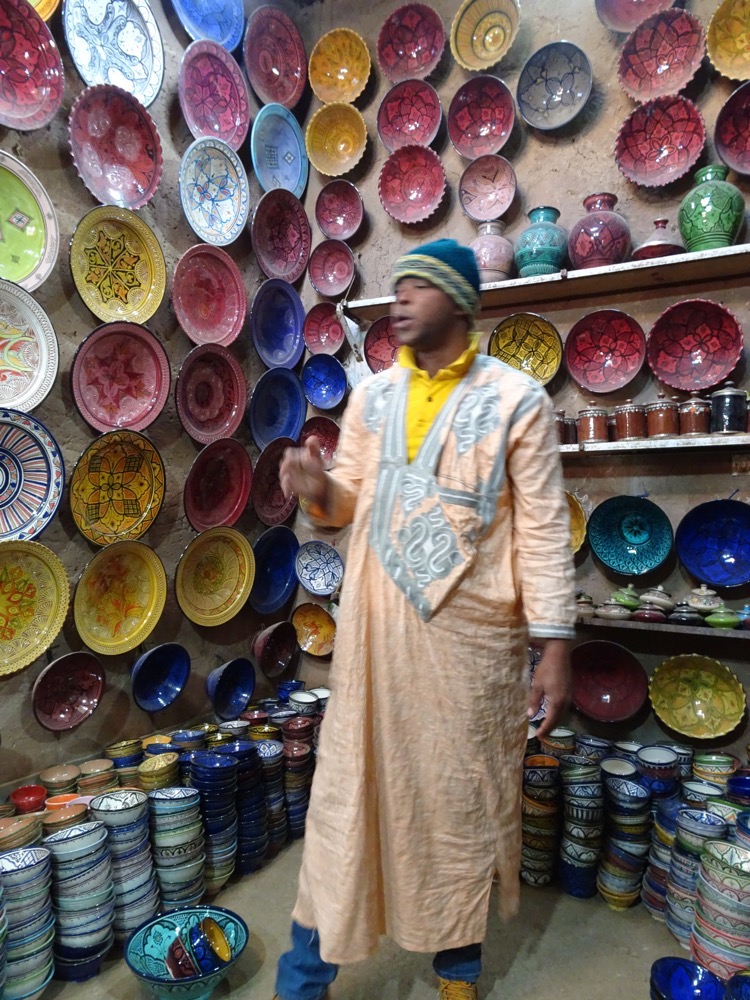
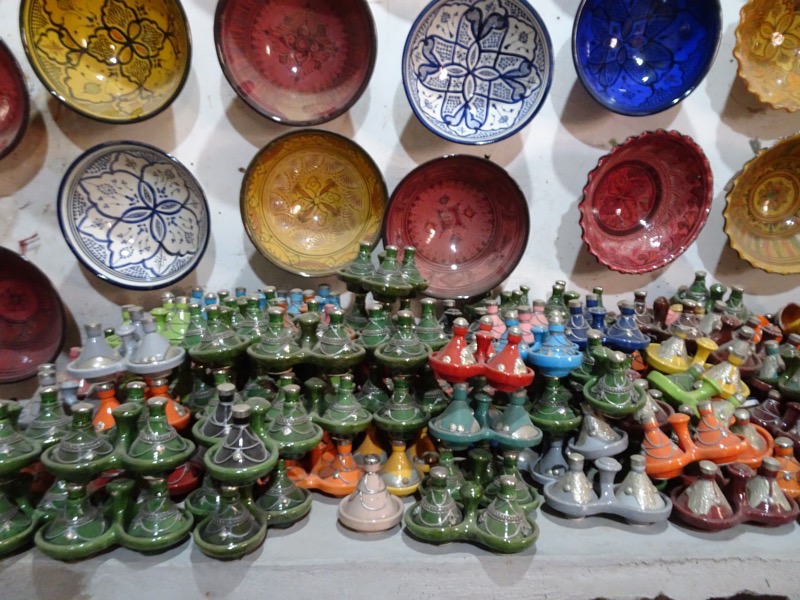 This particuarly green glazed style of tagine is unique to this region of South East Morocco. Tagines up and down the country are usually terracotta, but here they make distinctive green ceramics. We also for the first time saw domed shaped tagines rather than the usual funnel shamed ones. Apparently, they are used to create more steam in the tagine and allow red meat dishes to be cooked quicker.
This particuarly green glazed style of tagine is unique to this region of South East Morocco. Tagines up and down the country are usually terracotta, but here they make distinctive green ceramics. We also for the first time saw domed shaped tagines rather than the usual funnel shamed ones. Apparently, they are used to create more steam in the tagine and allow red meat dishes to be cooked quicker.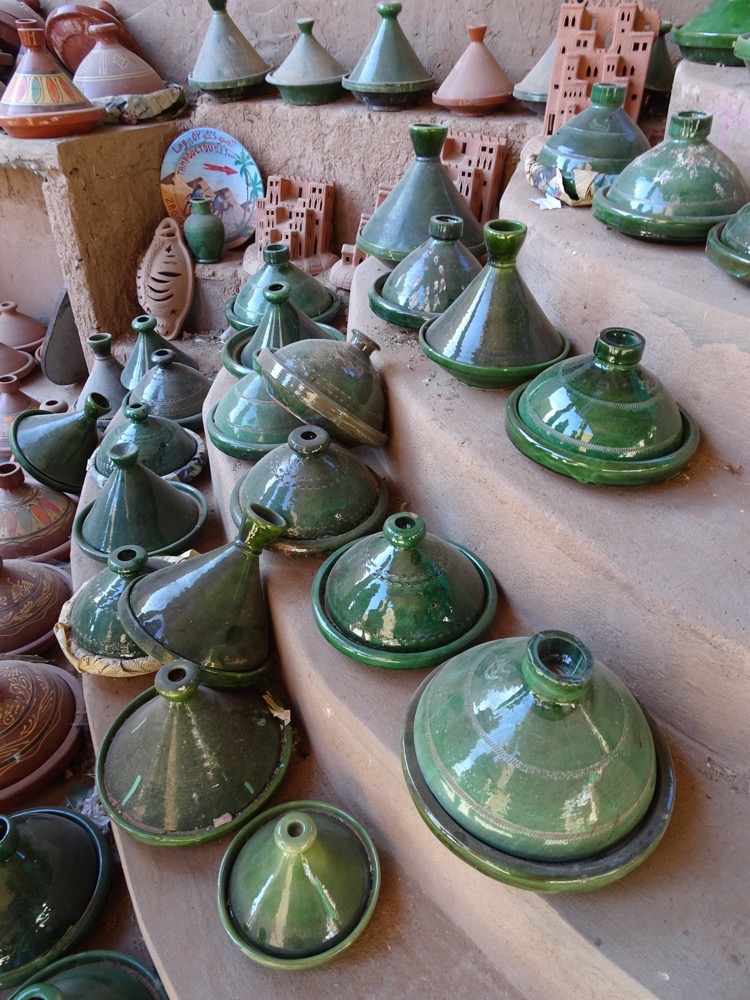 It was about this point that a few of us needed to use the bathroom – now, we have been educating our fellow travellers on the Happy Room Rating System, and this was barely a 1 Star Happy Room – no paper, a toilet that was flushing somewhat temporamentally, and water all over the floor but it was free and it had a door, so 1 Star. When I found the bathroom, there were our two young American lads, Jake and Tyson looking at each other awkwardly wondering how they were going to go to the loo. I didn’t get it? They didn’t have to sit down, they didn’t need for paper and yet, they were too cowardly to use the ‘facilities’ (oh yeah, I’m using that term loosely!). I said ‘Get out of the way boys.’ and in I went. Hiked up the bottoms of my jeans, one piece of paper to wipe the seat, a spare one for me and a guard to watch the door that didn’t have a latch and a well practiced hover pee later and out I came. The boys were standing there saying ‘You’re braver than me!’… to which I repsonded – ‘Once you’ve peed in Asia, you can pee anywhere!’. Having said that, I still think the worst loo I ever encountered was at an internet cafe run by a bunch of geeks in southern Turkey…
It was about this point that a few of us needed to use the bathroom – now, we have been educating our fellow travellers on the Happy Room Rating System, and this was barely a 1 Star Happy Room – no paper, a toilet that was flushing somewhat temporamentally, and water all over the floor but it was free and it had a door, so 1 Star. When I found the bathroom, there were our two young American lads, Jake and Tyson looking at each other awkwardly wondering how they were going to go to the loo. I didn’t get it? They didn’t have to sit down, they didn’t need for paper and yet, they were too cowardly to use the ‘facilities’ (oh yeah, I’m using that term loosely!). I said ‘Get out of the way boys.’ and in I went. Hiked up the bottoms of my jeans, one piece of paper to wipe the seat, a spare one for me and a guard to watch the door that didn’t have a latch and a well practiced hover pee later and out I came. The boys were standing there saying ‘You’re braver than me!’… to which I repsonded – ‘Once you’ve peed in Asia, you can pee anywhere!’. Having said that, I still think the worst loo I ever encountered was at an internet cafe run by a bunch of geeks in southern Turkey…
After out visit to the ceramics cooperative, we were back on the road again heading for the Sahara camp. The occasional photo stop is always welcome as a chance to get off the bus and stretch out legs.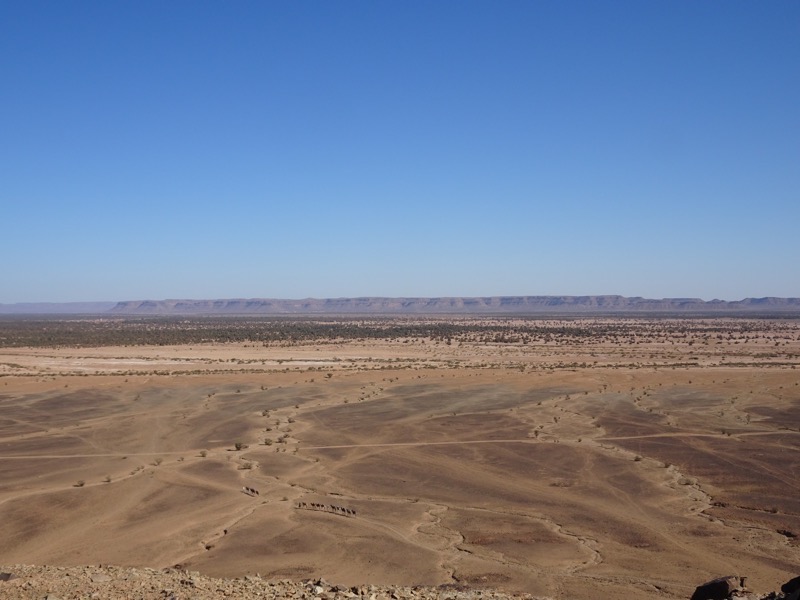 In among this gorgeous desert landscape was a camel train…
In among this gorgeous desert landscape was a camel train…  The gang enjoying the views.
The gang enjoying the views.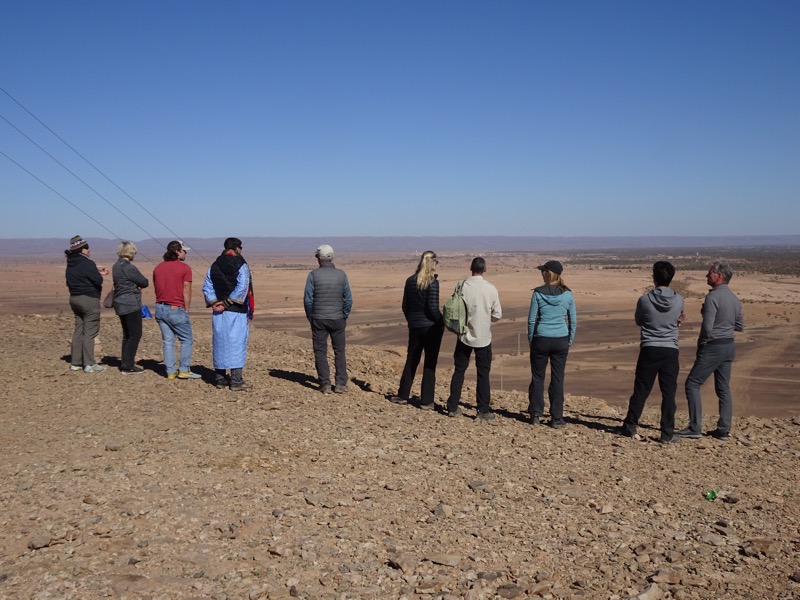 Not too far down the road, we arrived at the small town of Mhamid and joined our 4×4 convoy and loaded up to head to the desert. We drove down the road a short way and then the road just disappeared. Suddeny the little town Mhamid was gone and we were faced with this:
Not too far down the road, we arrived at the small town of Mhamid and joined our 4×4 convoy and loaded up to head to the desert. We drove down the road a short way and then the road just disappeared. Suddeny the little town Mhamid was gone and we were faced with this: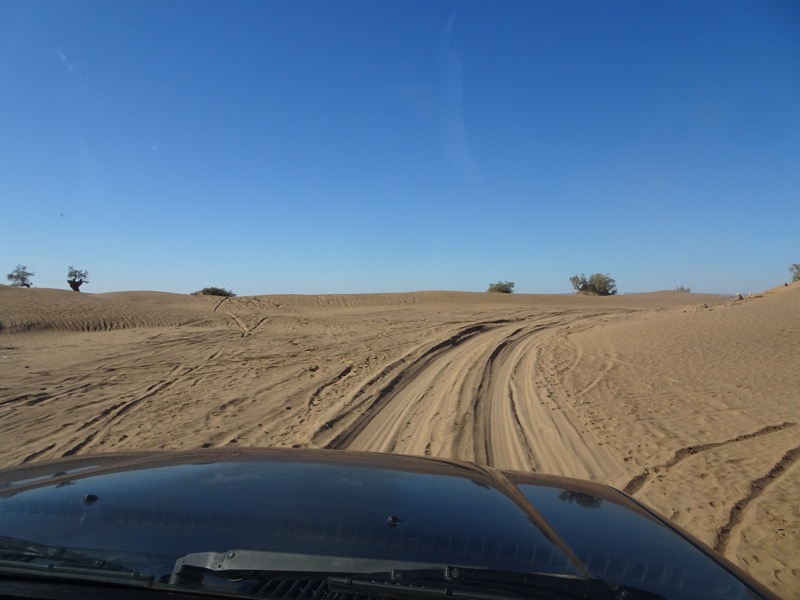 The landscape seemed to change dramatically form sandy and dry to rokcy and dry to dry lake/creek bed and dry.
The landscape seemed to change dramatically form sandy and dry to rokcy and dry to dry lake/creek bed and dry.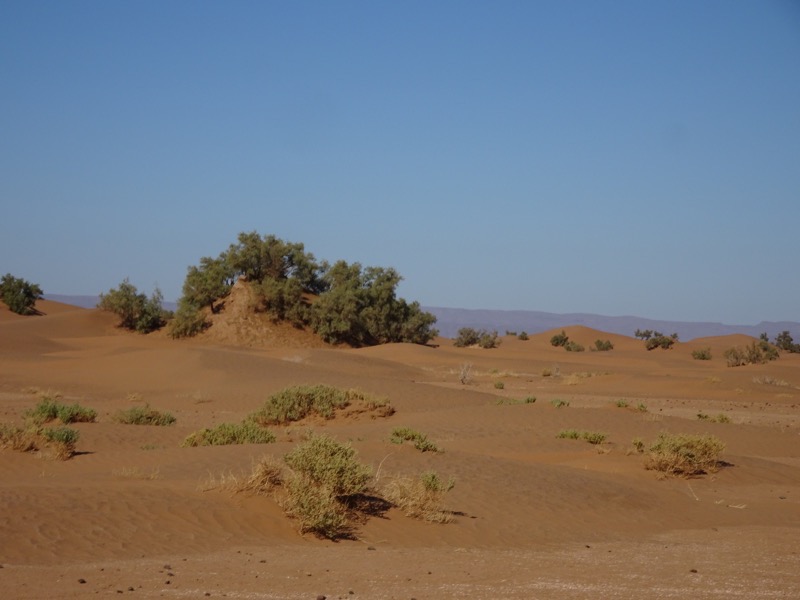 Not much was growing here but there were Arugala plants – who knew they were a desert plant?!
Not much was growing here but there were Arugala plants – who knew they were a desert plant?!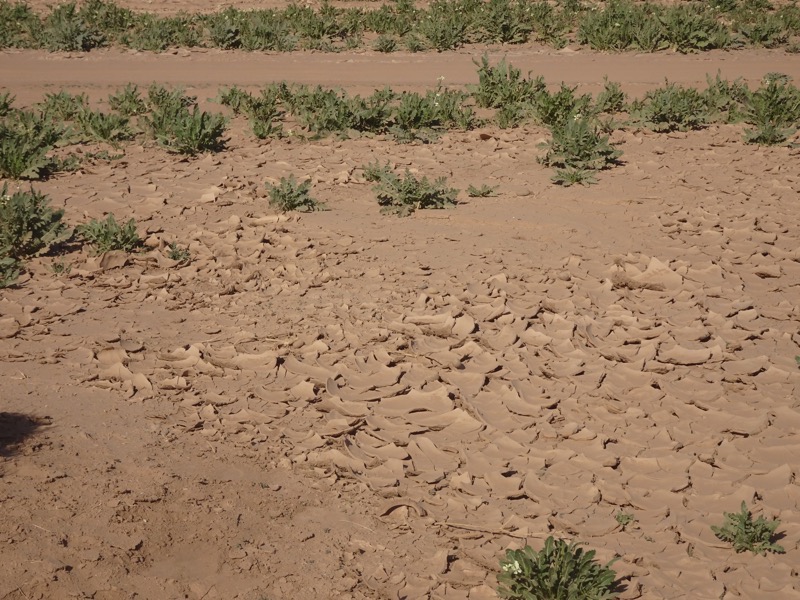 About an our into our drive (with a driver named Mohammed who ‘drove it like he stole it!’) we stopped at a bee keeper’s place. Of all things! There
About an our into our drive (with a driver named Mohammed who ‘drove it like he stole it!’) we stopped at a bee keeper’s place. Of all things! There
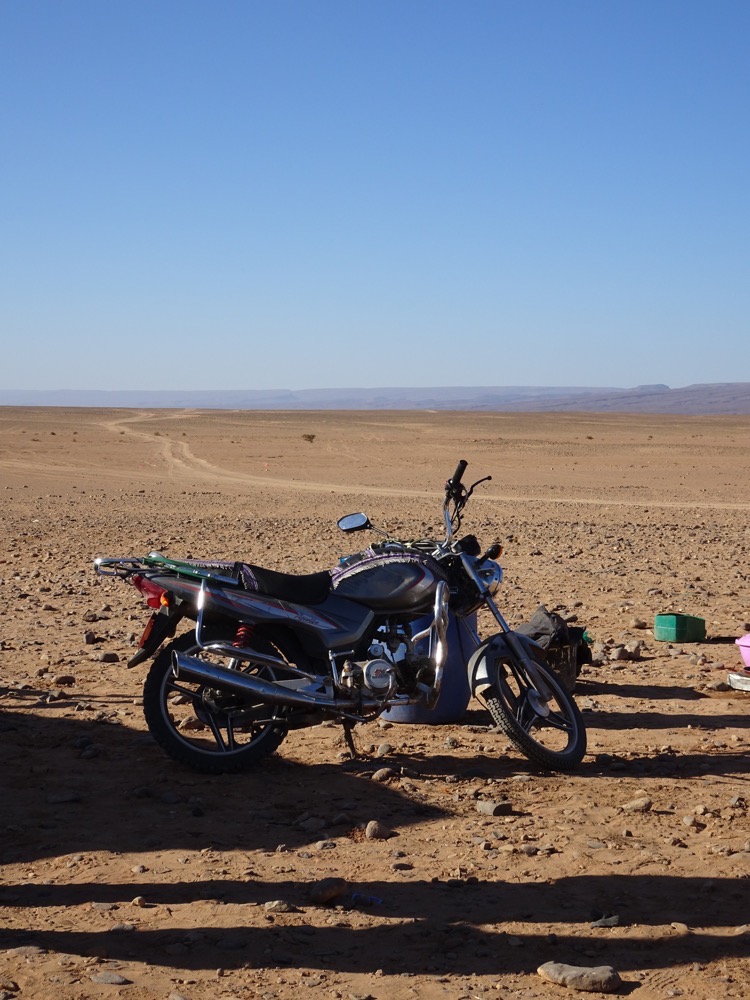 We all got to try the honey which had an extremly distinctive taste having largely come from the flowers on the arugala plants.
We all got to try the honey which had an extremly distinctive taste having largely come from the flowers on the arugala plants.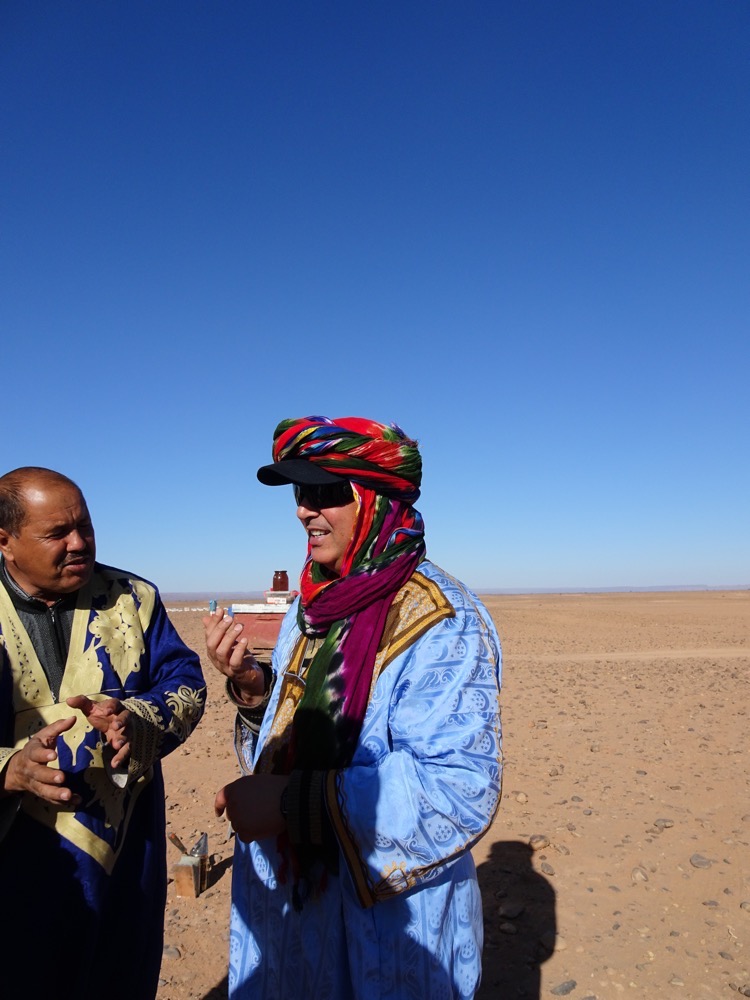
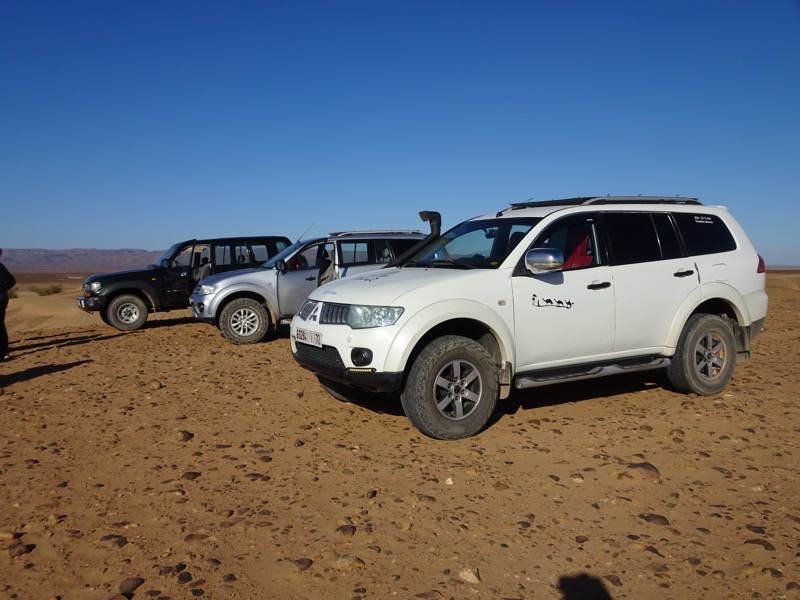 Before we knew it, our convoy had arrived at the camp. We were greeted with Moroccan mint tea, of course and a few minutes to settle ourselves into our ‘tents’. To be honest, the facilities out here were way better than expected. Our tents were made of extremely well insulating traditional mud brick walls, lined outside with wool.
Before we knew it, our convoy had arrived at the camp. We were greeted with Moroccan mint tea, of course and a few minutes to settle ourselves into our ‘tents’. To be honest, the facilities out here were way better than expected. Our tents were made of extremely well insulating traditional mud brick walls, lined outside with wool.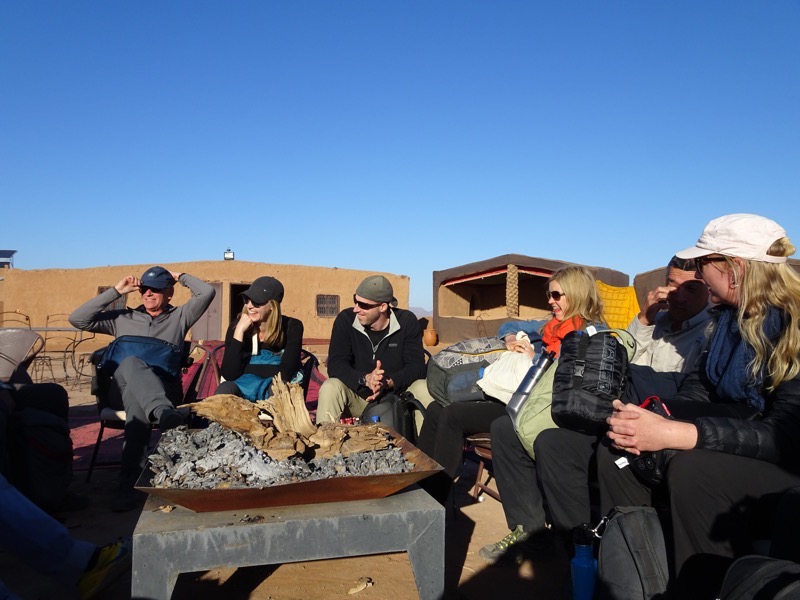
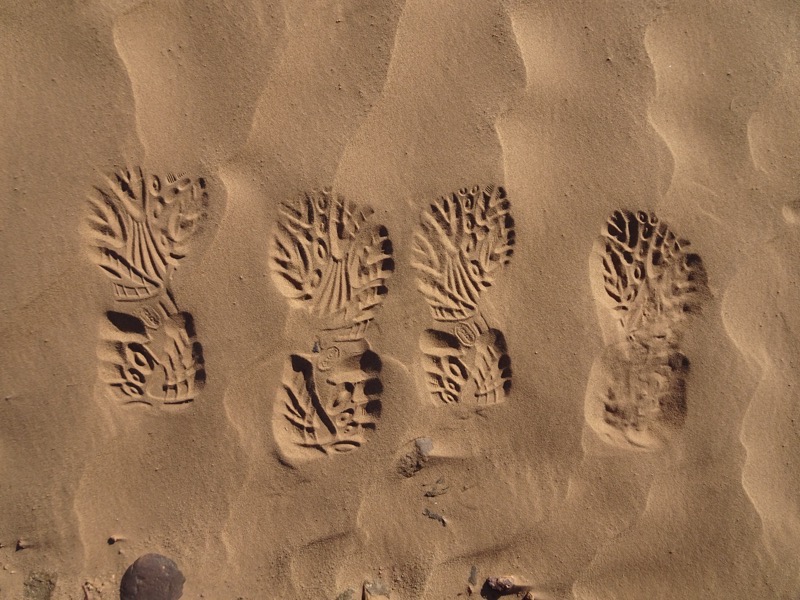
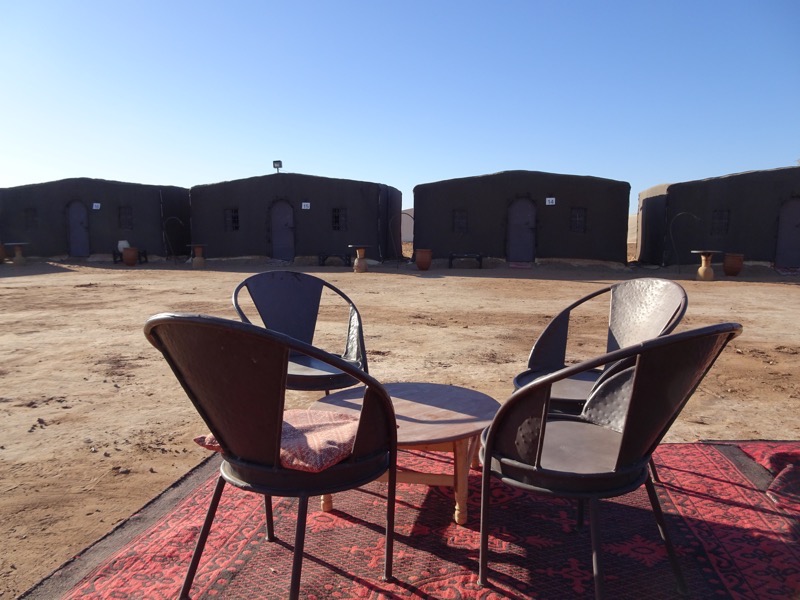
 After tea and a 15 min break it was time to go find a camel! As we were riding the camels up into the dunes to see the sunset.
After tea and a 15 min break it was time to go find a camel! As we were riding the camels up into the dunes to see the sunset.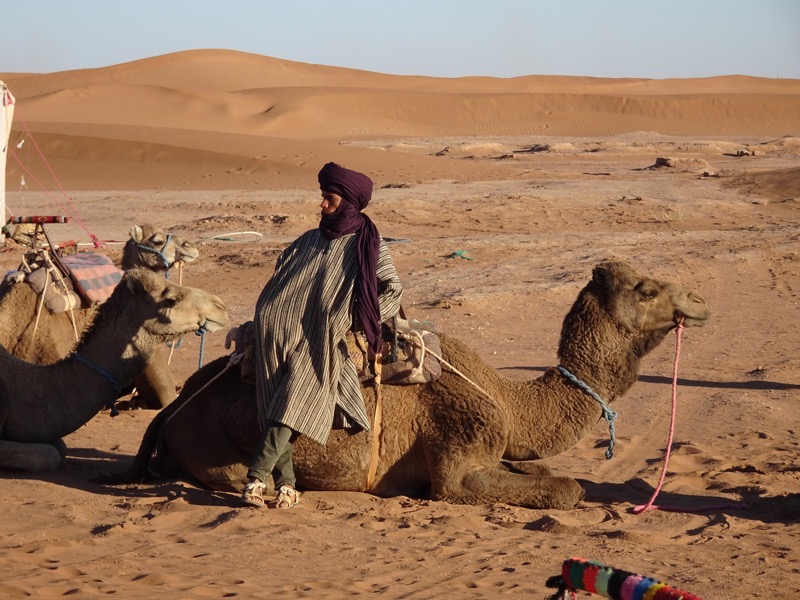
 This is the camel I rode up the sand dunes. This poor camel also was nameless – it seems giving beasts of burden a name is not the done thing in Morocco. The camels live to be about 13, and most of these animals were in their prime at 5-7 years old.
This is the camel I rode up the sand dunes. This poor camel also was nameless – it seems giving beasts of burden a name is not the done thing in Morocco. The camels live to be about 13, and most of these animals were in their prime at 5-7 years old. One yawned at me which I found somewhat disturbing. I don’t know what passes for ‘normal’ camel orthadonture, but the poor thing appeared to have hardly any upper teeth! There was another camel in the group that seemed to be grinding his teeth all afternoon, though I know not why.
One yawned at me which I found somewhat disturbing. I don’t know what passes for ‘normal’ camel orthadonture, but the poor thing appeared to have hardly any upper teeth! There was another camel in the group that seemed to be grinding his teeth all afternoon, though I know not why.


Our little camel ride into the Sahara was quite fun, and riding Nameles Camel Number 3 was a lot easier than riding Frank the Mule the other day The regular loping gait of the camel was far easier to deal with than the irregular all over the place side to side motion of the mule.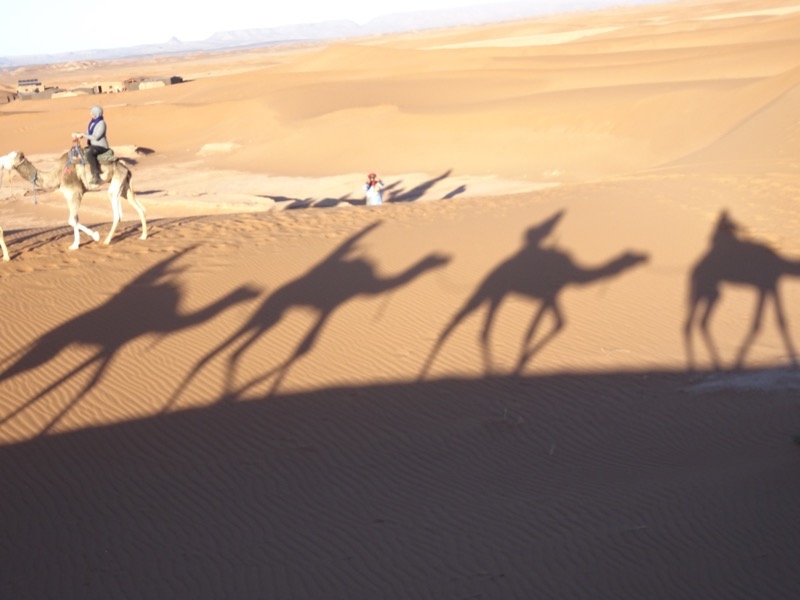
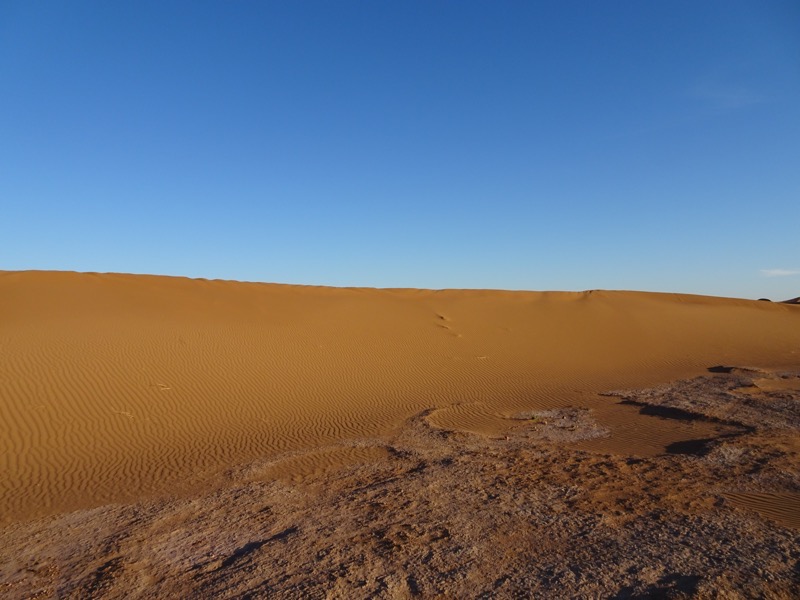

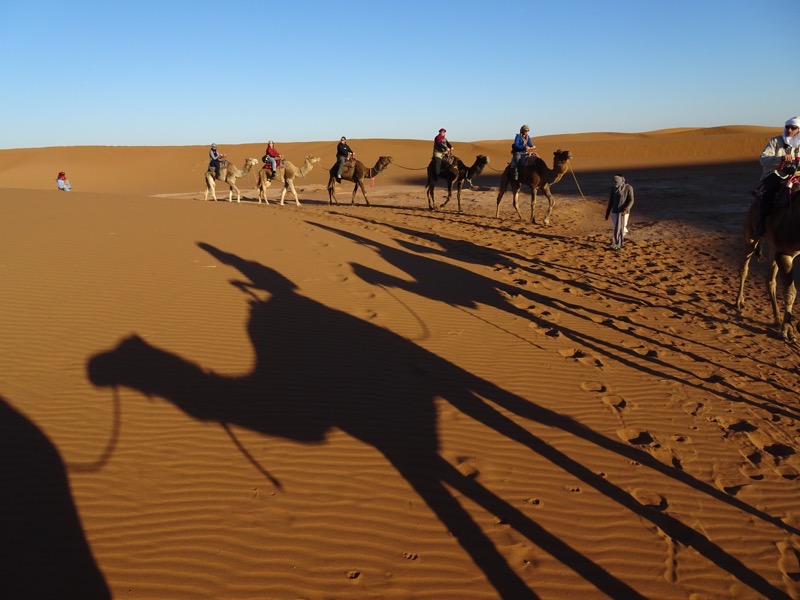 Out there beyond Samirr is the Moroccan/Algerian border, barely 30 kms away. This has been hotly contest property for nearly 50 years now and the last King made it a seriously unsafe proposition for the Algerians to try and enter the country by effectively creating an enormous strip of ‘no man’s land’ by planting tens of thousands of land mines all along the Moroccan border between the two countiries to keep the Algerians out… I bet no one was claiming the old king of Morocco is soft on immigration!
Out there beyond Samirr is the Moroccan/Algerian border, barely 30 kms away. This has been hotly contest property for nearly 50 years now and the last King made it a seriously unsafe proposition for the Algerians to try and enter the country by effectively creating an enormous strip of ‘no man’s land’ by planting tens of thousands of land mines all along the Moroccan border between the two countiries to keep the Algerians out… I bet no one was claiming the old king of Morocco is soft on immigration! The view from the top of the sand dunes looking to the east.
The view from the top of the sand dunes looking to the east. The sunset was spectacular – everyone who walked up that stupid dune seemed to really enjoy it.t
The sunset was spectacular – everyone who walked up that stupid dune seemed to really enjoy it.t
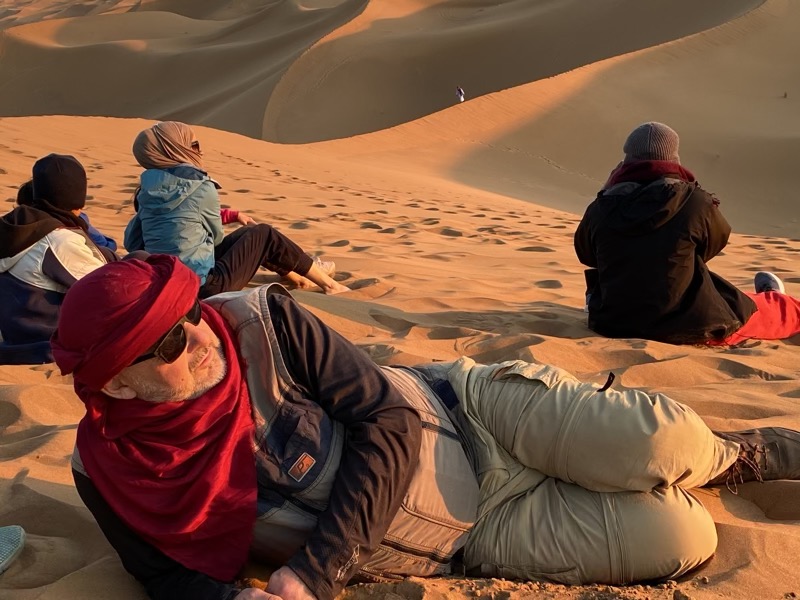

 Sadly, we did have to return our camels and go get washed up for dinner.
Sadly, we did have to return our camels and go get washed up for dinner.  Which was served in a restaurant in the cmpsites – again way more swish than I anticipated.
Which was served in a restaurant in the cmpsites – again way more swish than I anticipated. The enormous chicken tagines that were served fro dinner. Absolutely dieicious.
The enormous chicken tagines that were served fro dinner. Absolutely dieicious. After this we’d had a few drinks over dinner, some of us congregated around the bon fire, but it was stariting to get seriously cold – so we had a quick shower (it was hot thank fuck; almost too hot!) before turning in and sleeping the exhuasted and slightly inebriated sleep we so richly deserved.
After this we’d had a few drinks over dinner, some of us congregated around the bon fire, but it was stariting to get seriously cold – so we had a quick shower (it was hot thank fuck; almost too hot!) before turning in and sleeping the exhuasted and slightly inebriated sleep we so richly deserved.

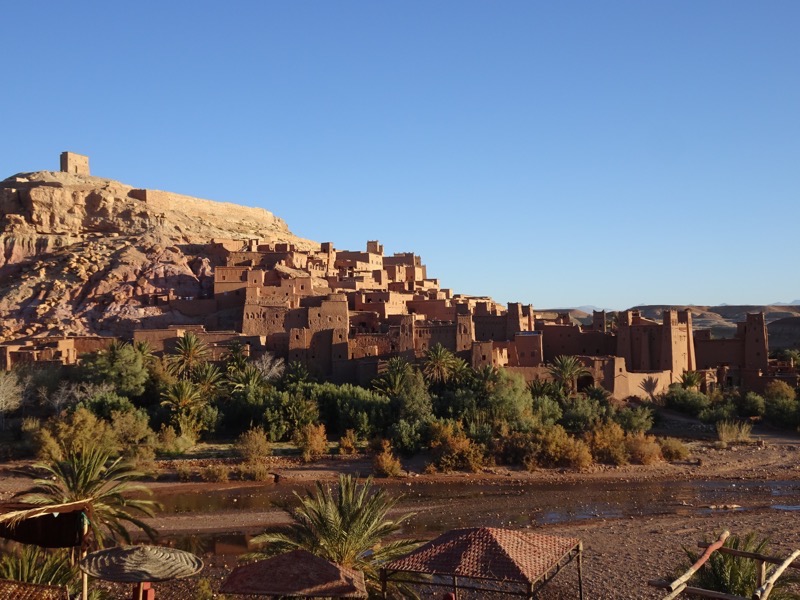 We started out day off this morning with a spot of rug shopping at a local women’s weaving cooperative. The Berber style of rugs prevalent throughout Morocco is quite distinctive. They’re very busy and have a lot of motifs (many of which are for good luck or fertility) that repeat through the patterns. They’re also really asymmetrical compared to other hand made rugs that you usually see coming out of Eurasia and the Middle East.
We started out day off this morning with a spot of rug shopping at a local women’s weaving cooperative. The Berber style of rugs prevalent throughout Morocco is quite distinctive. They’re very busy and have a lot of motifs (many of which are for good luck or fertility) that repeat through the patterns. They’re also really asymmetrical compared to other hand made rugs that you usually see coming out of Eurasia and the Middle East.  The boys looked very exciting for their second foray into Berber home furnishings.
The boys looked very exciting for their second foray into Berber home furnishings. Our hosts laid out about 100 rugs for our viewing pleasure… some of them gorgeous, some of them downright hard on the eyes. We seemed to have an extraordinary shopping experience this morning. These rugs actually had prices on them, which is unusual in places where you expect to barter (ie: where they really truly want to fleece the tourists good and proper), and the marked prices were quite reasonable compared to what we had seen in other rug shops in the various medinas.
Our hosts laid out about 100 rugs for our viewing pleasure… some of them gorgeous, some of them downright hard on the eyes. We seemed to have an extraordinary shopping experience this morning. These rugs actually had prices on them, which is unusual in places where you expect to barter (ie: where they really truly want to fleece the tourists good and proper), and the marked prices were quite reasonable compared to what we had seen in other rug shops in the various medinas.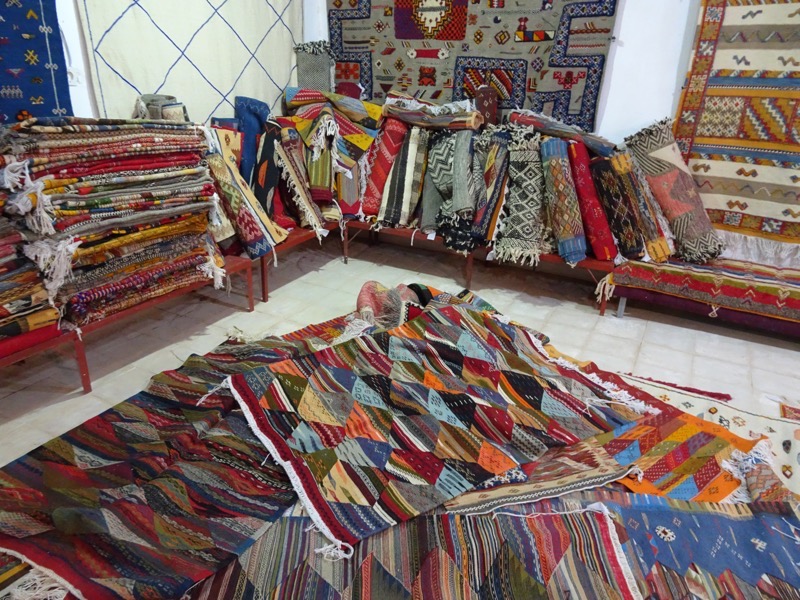 Mr K getting worried for his wallet…
Mr K getting worried for his wallet…


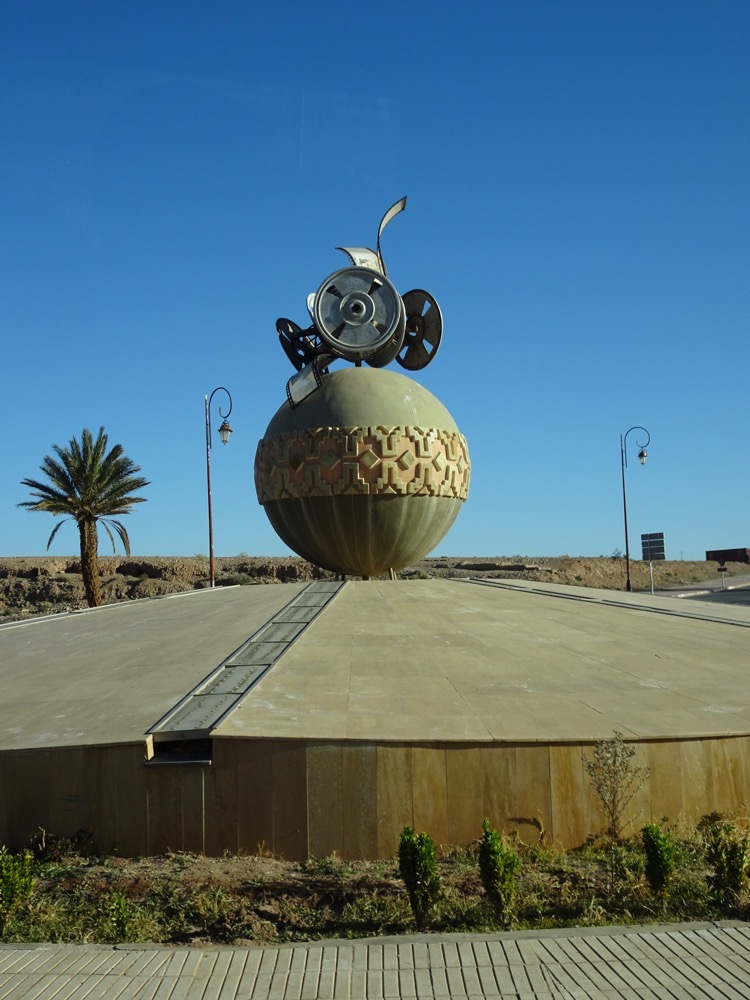 Very quickly though we were into the mountains again and into the pass. Unlike the terrain around Aroumd which was formed by glaciers, this entire area was formed by volcanic actions however many millions of years ago. You can see the swirling layers of rock that form the desert. It’s so dry here and barely a tree in sight.
Very quickly though we were into the mountains again and into the pass. Unlike the terrain around Aroumd which was formed by glaciers, this entire area was formed by volcanic actions however many millions of years ago. You can see the swirling layers of rock that form the desert. It’s so dry here and barely a tree in sight.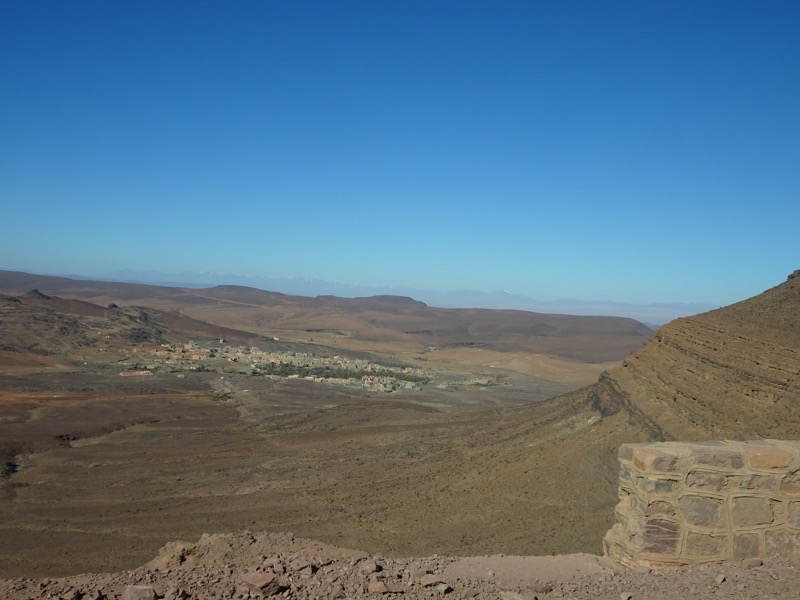 It beggars belief as to why you would bulid here, but there are the Berber people who live in these walled towns, and Bedouin and nomadic people who used to raid them all fighting for resources in the region. Each little town has a kasbah or fortress which can be retreated to when the nomads or Bedouins come invading…?
It beggars belief as to why you would bulid here, but there are the Berber people who live in these walled towns, and Bedouin and nomadic people who used to raid them all fighting for resources in the region. Each little town has a kasbah or fortress which can be retreated to when the nomads or Bedouins come invading…?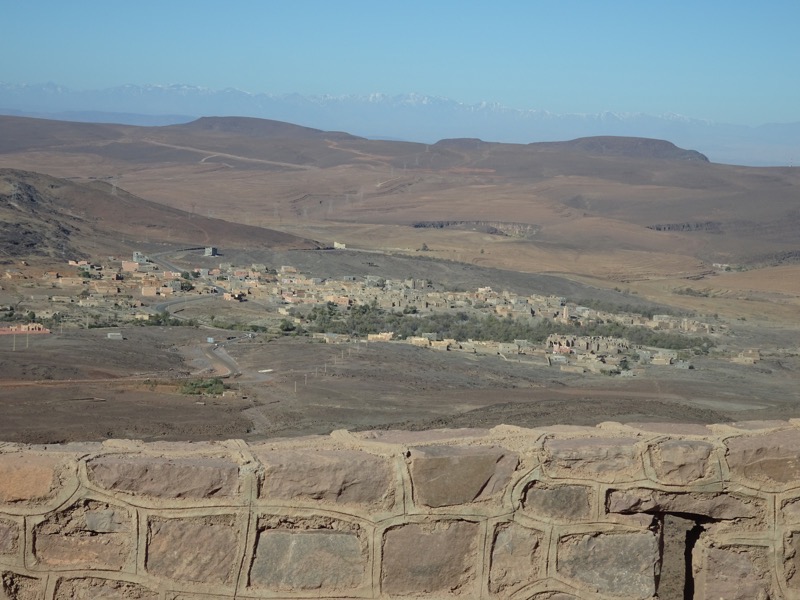 The scenery was really impessive, enormous rocky canyons, and steep cliffs as we approced the mountain pass which was 1800m above sea level (much lower than Aroumd at 2640m).
The scenery was really impessive, enormous rocky canyons, and steep cliffs as we approced the mountain pass which was 1800m above sea level (much lower than Aroumd at 2640m).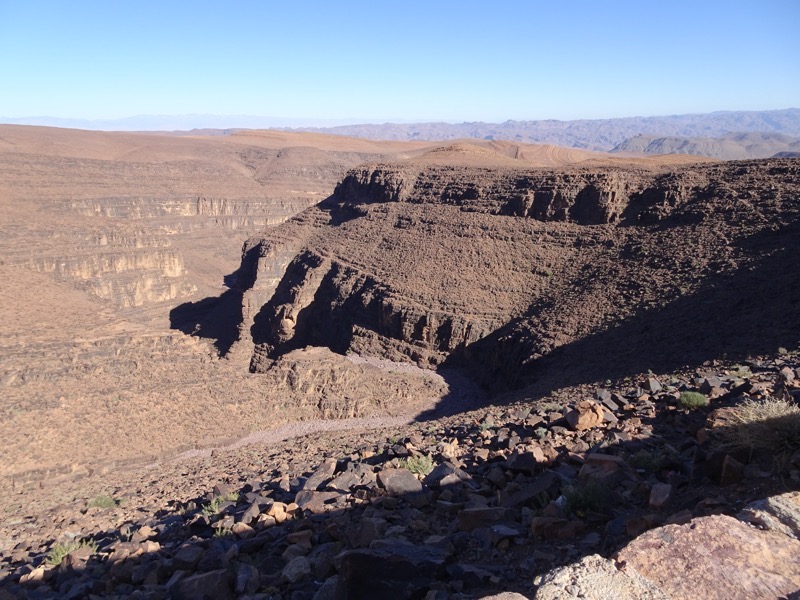 The rock formations were enormous and amazing… and unbelievably, on occasion, we could see handfuls of little black dots on these extremely arid areas. Little black dots that would turn out to be goats and a shepherd. Unfortunately, I didn’t manage to grab a photo of one of these herds of goats (herd? flocks? pack? *shrug* (Fuck who what the collective noun for a group of goats is?).
The rock formations were enormous and amazing… and unbelievably, on occasion, we could see handfuls of little black dots on these extremely arid areas. Little black dots that would turn out to be goats and a shepherd. Unfortunately, I didn’t manage to grab a photo of one of these herds of goats (herd? flocks? pack? *shrug* (Fuck who what the collective noun for a group of goats is?).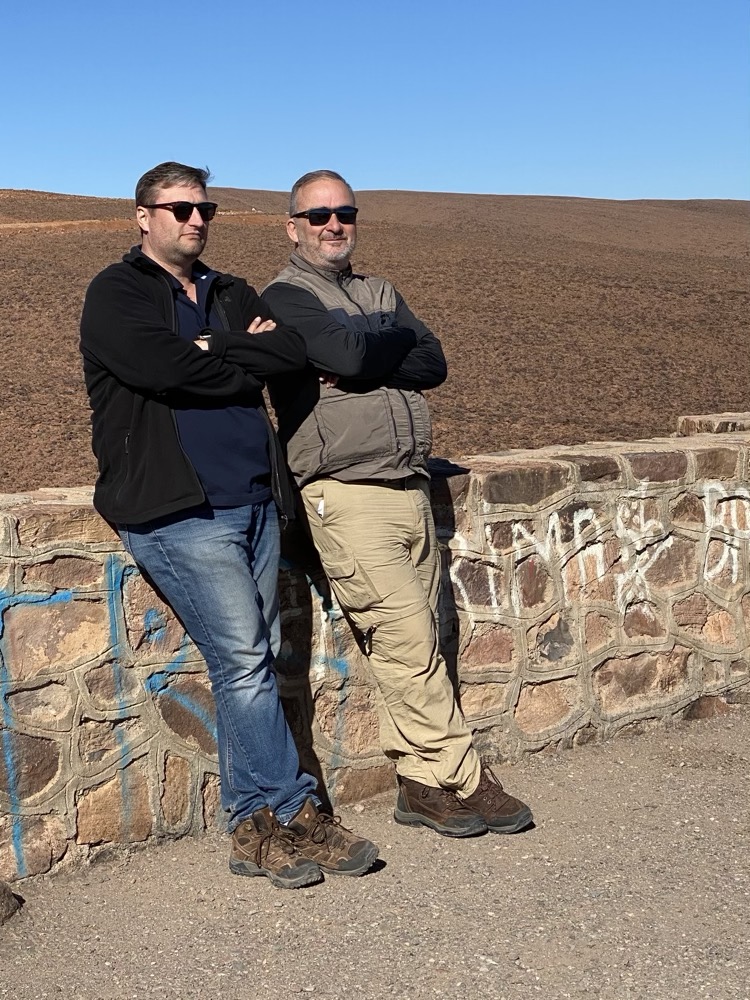
 Once we had passed the pass, we found ourselves in the ‘oasis’. Now this confused me somewhat – I always though an oasis was a spring of some sort in the middle of the desert. A kinda Disneyeque situation where there’s nothing but sand in every direction and suddenly a small pool of fresh water with four or five palm trees… but not so! This oasis spans 200kms down the valley and supports an enormous amount of people, commerce and agriculture.
Once we had passed the pass, we found ourselves in the ‘oasis’. Now this confused me somewhat – I always though an oasis was a spring of some sort in the middle of the desert. A kinda Disneyeque situation where there’s nothing but sand in every direction and suddenly a small pool of fresh water with four or five palm trees… but not so! This oasis spans 200kms down the valley and supports an enormous amount of people, commerce and agriculture. 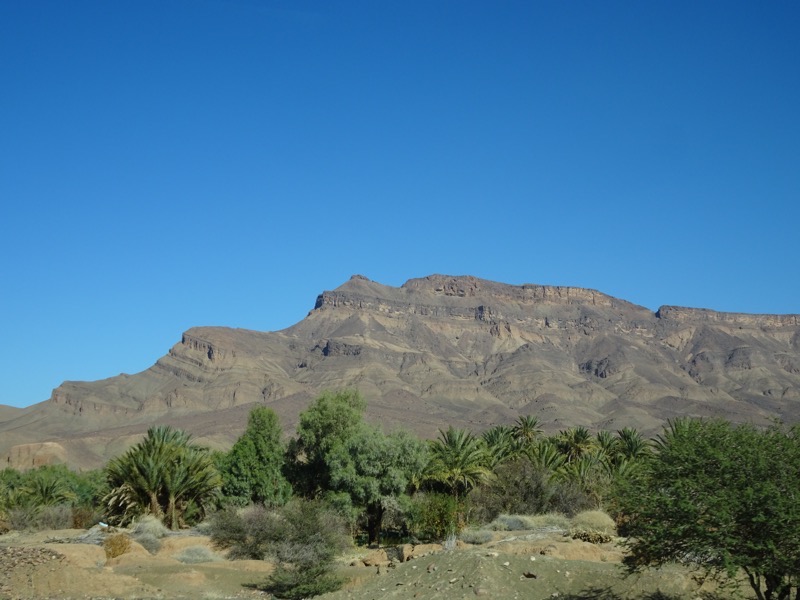 The mountain is Mt Kissane, and the oasis here supports and enormous date palm industry which spans the entire 200km length. It was along this oasis that we stopped for a picnic lunch at a ‘truck stop’ (which looked more like a fancy hotel). At lunchtime, I asked Samirr if he could enquire about the young woman from Aroumd who had tried to jump from the mountain… being stuck on the bus for hours, my mind kept wandering back to how the lack of education and bullshit religious superstitions may have driven this poor woman to desperation – he made a phone call and found out that she suffered only a broken leg and a broken jaw, and was due to have a surgery on both today. I’d like to think she will get the medical attention she needs for her epilepsy, and her subsequent mental health issues… but I somehow strongly doubt it.
The mountain is Mt Kissane, and the oasis here supports and enormous date palm industry which spans the entire 200km length. It was along this oasis that we stopped for a picnic lunch at a ‘truck stop’ (which looked more like a fancy hotel). At lunchtime, I asked Samirr if he could enquire about the young woman from Aroumd who had tried to jump from the mountain… being stuck on the bus for hours, my mind kept wandering back to how the lack of education and bullshit religious superstitions may have driven this poor woman to desperation – he made a phone call and found out that she suffered only a broken leg and a broken jaw, and was due to have a surgery on both today. I’d like to think she will get the medical attention she needs for her epilepsy, and her subsequent mental health issues… but I somehow strongly doubt it.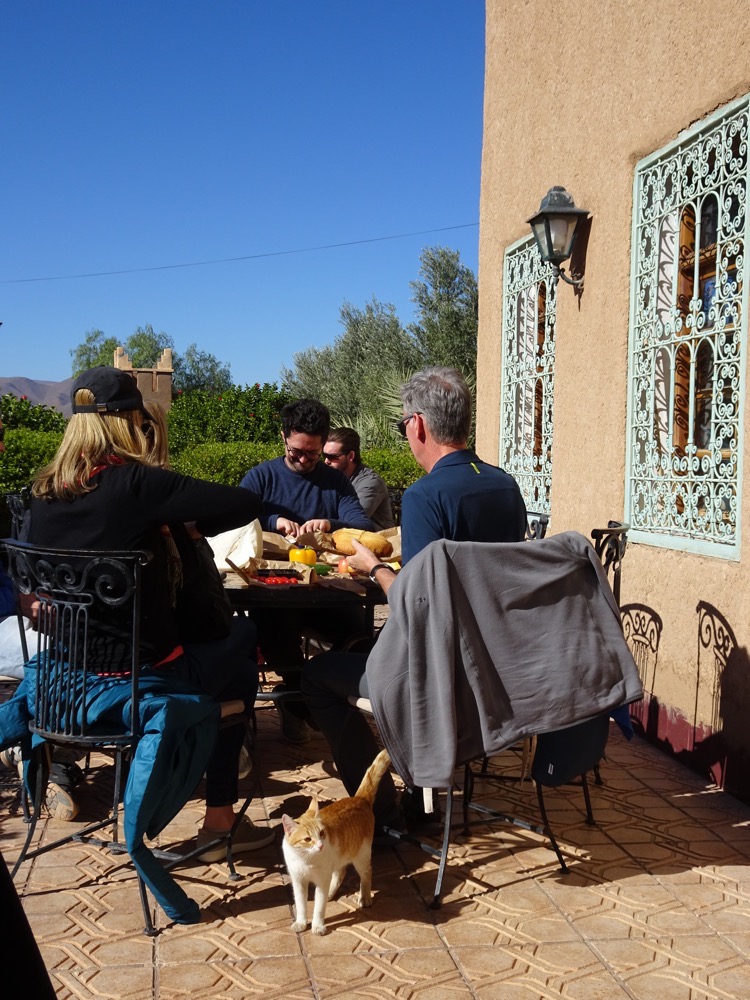 Anyway. Another day another earworm. Every time Samirr mentioned the oasis, I could hear ‘Midnight at the oasis, send your camel to bed…’ going through my head. We followed the palms and the mountains for a few hours.
Anyway. Another day another earworm. Every time Samirr mentioned the oasis, I could hear ‘Midnight at the oasis, send your camel to bed…’ going through my head. We followed the palms and the mountains for a few hours. With beautiful, typically Moroccan vistas in every direction – this is more like what I expected Morocco to look like, not the lush green rolling hills of the north. This was the only that I actually saw the water source that was sustaining all this growth: the Draa River which feeds the entire valley.
With beautiful, typically Moroccan vistas in every direction – this is more like what I expected Morocco to look like, not the lush green rolling hills of the north. This was the only that I actually saw the water source that was sustaining all this growth: the Draa River which feeds the entire valley. 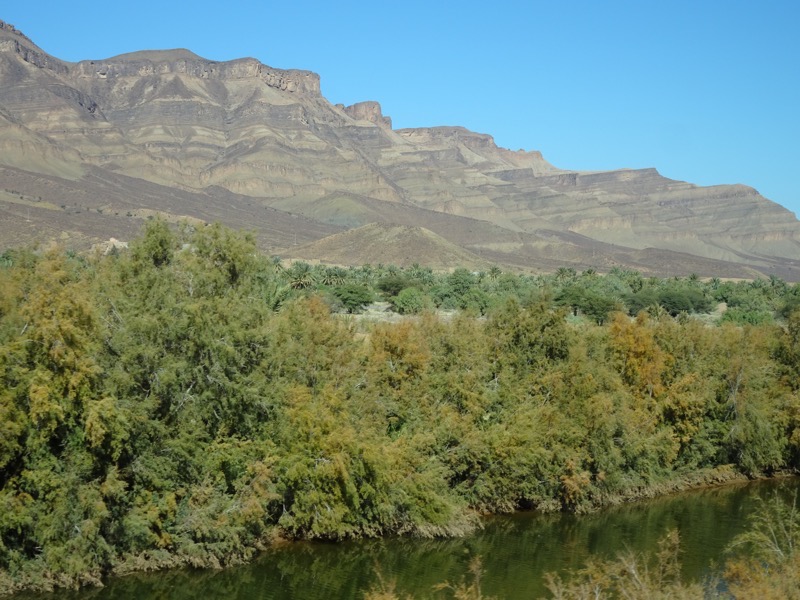
 We did one stop and it was date palms as far as the eye could see.
We did one stop and it was date palms as far as the eye could see.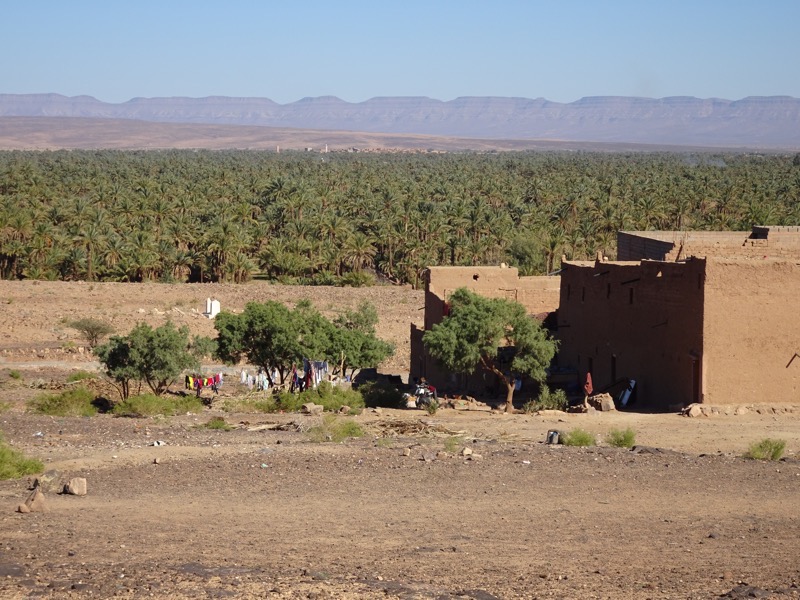
 Eventually, our drive came to an end and we arrived at Zagora. Zagora is the major town in the Draa River valley. So anyone in the entire Drâa-Tafilalet region in this part of the country comes here for major supplies. The town is flanked by the mountain Zagora from which it derives its name.
Eventually, our drive came to an end and we arrived at Zagora. Zagora is the major town in the Draa River valley. So anyone in the entire Drâa-Tafilalet region in this part of the country comes here for major supplies. The town is flanked by the mountain Zagora from which it derives its name. Pretty swish for being in the middle of nowhere.
Pretty swish for being in the middle of nowhere.
 After we got settled, we went for a ‘gently walk for an hour and a half through the date palm trees of the oasis’, which turned out to be nearly a 6km walk, an easy third of which was over fucking sand dunes. Nice one! I wasn’t wearing my boots, just sneakers, and was exhausted from five hours being jostled around in the bus for most of the day, and here were expecting a nice easy walk in the cool of the palm trees, and instead, we were slogging over two kms of fucking sand dunes to see… well, I still don’t really know what?!
After we got settled, we went for a ‘gently walk for an hour and a half through the date palm trees of the oasis’, which turned out to be nearly a 6km walk, an easy third of which was over fucking sand dunes. Nice one! I wasn’t wearing my boots, just sneakers, and was exhausted from five hours being jostled around in the bus for most of the day, and here were expecting a nice easy walk in the cool of the palm trees, and instead, we were slogging over two kms of fucking sand dunes to see… well, I still don’t really know what?!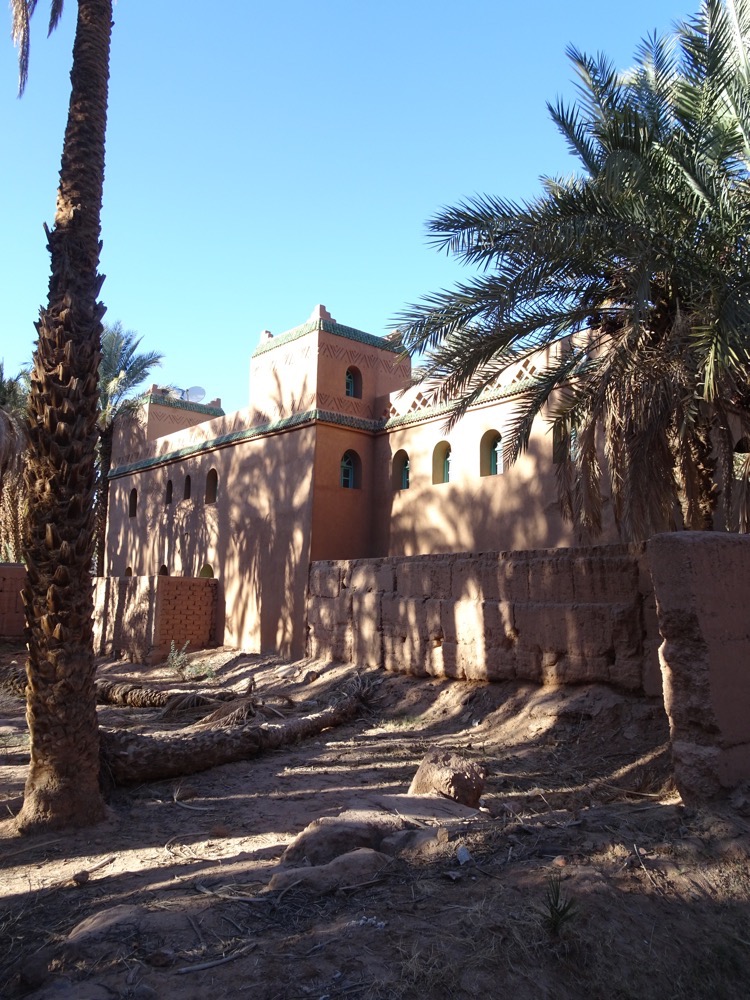 Following the paths through the palm trees in the oasis was a bit like winding through a medina – lots of nooks and crannies, cool door ways and arches.
Following the paths through the palm trees in the oasis was a bit like winding through a medina – lots of nooks and crannies, cool door ways and arches.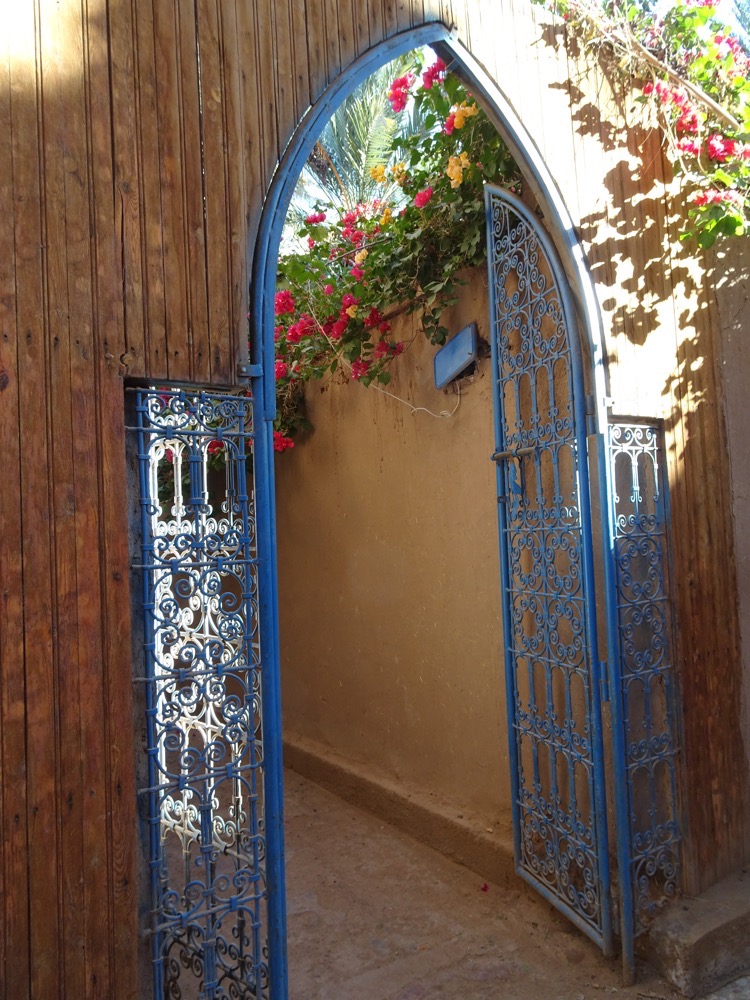
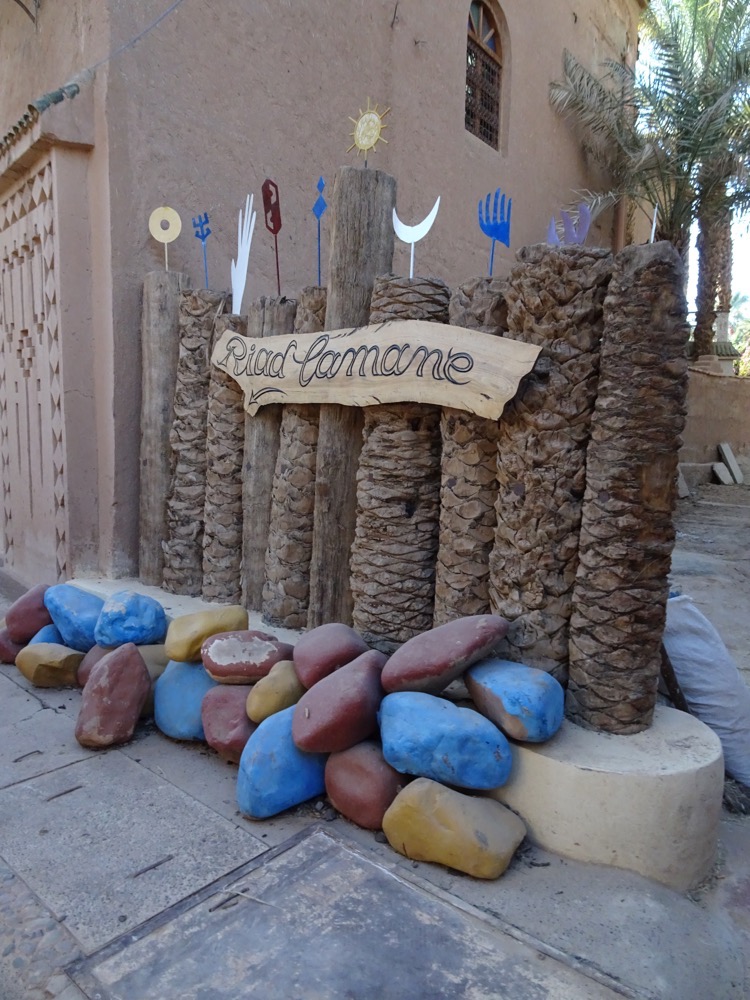 Many impressive building facades and doorways, that you would never know was in here among the palms.
Many impressive building facades and doorways, that you would never know was in here among the palms.
 At the base of the palms, there are small spaces of other produce being grown – turnips, henna, lucerne, alfalfa and the like.
At the base of the palms, there are small spaces of other produce being grown – turnips, henna, lucerne, alfalfa and the like.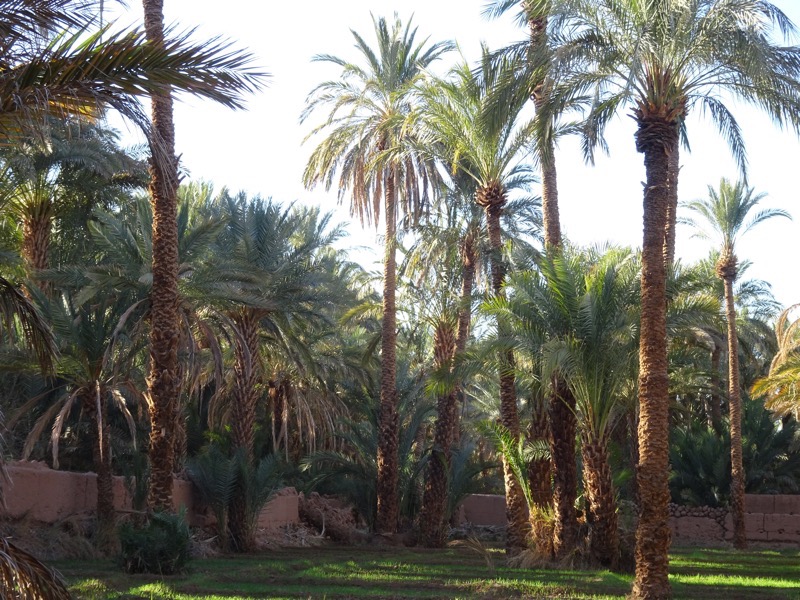 Samirr demonstrating how the locals climb the palm trees to trim the fronds off the trees. The trees themselves can live and keep bearing fruit for a century, but the fronds get cut off every five years or so. These fronds are used as a building material – primarily in the building of fences.
Samirr demonstrating how the locals climb the palm trees to trim the fronds off the trees. The trees themselves can live and keep bearing fruit for a century, but the fronds get cut off every five years or so. These fronds are used as a building material – primarily in the building of fences.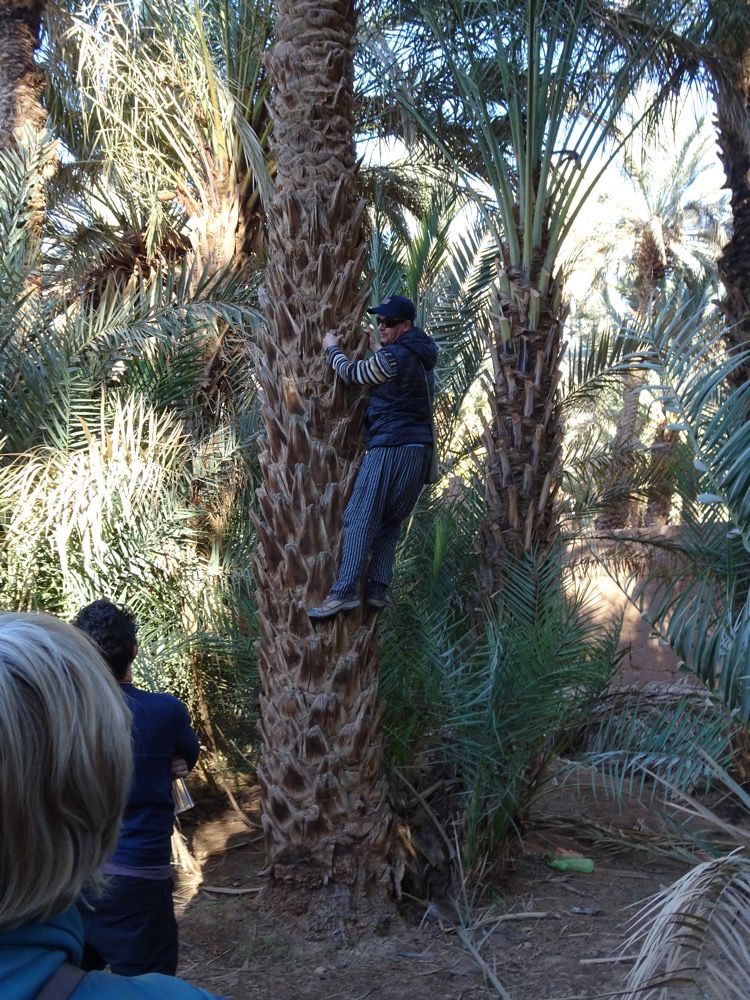


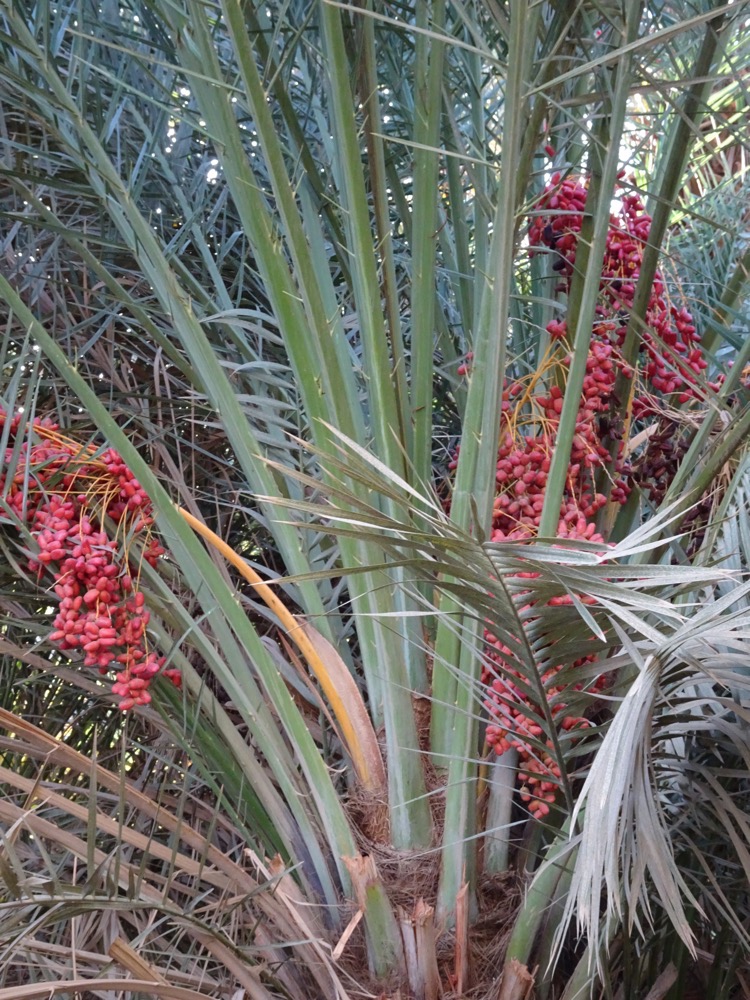
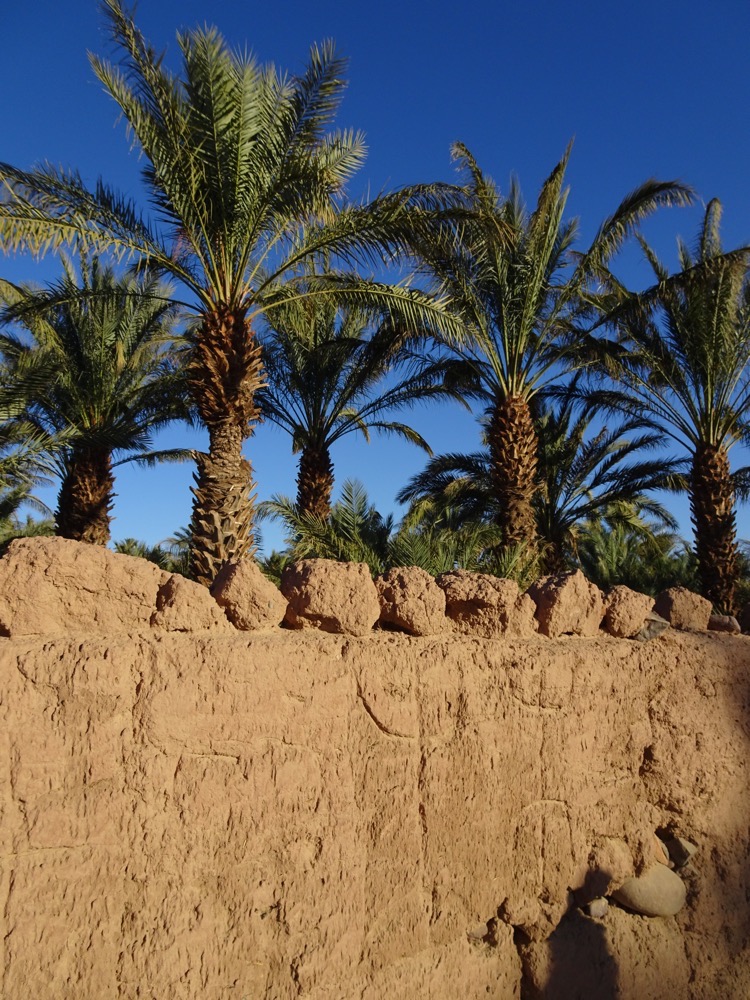 Here is where we saw the fronds coming into use as fencing – the oasis is a naturally occurring space thanks to the river that runs through the valley, but the Sahara is an ever-changing landscape that encroaches and retreats where it pleases. Here, in the oasis, the people have learned how to try and keep the Sahara at bay, by making fences to stop the sand dunes from overrunning their water sources and changing the geography. They weave the fronds into fences which are then laid out in a grid or checked type arrangement, so when the sand storms come, they hold back the sands.
Here is where we saw the fronds coming into use as fencing – the oasis is a naturally occurring space thanks to the river that runs through the valley, but the Sahara is an ever-changing landscape that encroaches and retreats where it pleases. Here, in the oasis, the people have learned how to try and keep the Sahara at bay, by making fences to stop the sand dunes from overrunning their water sources and changing the geography. They weave the fronds into fences which are then laid out in a grid or checked type arrangement, so when the sand storms come, they hold back the sands.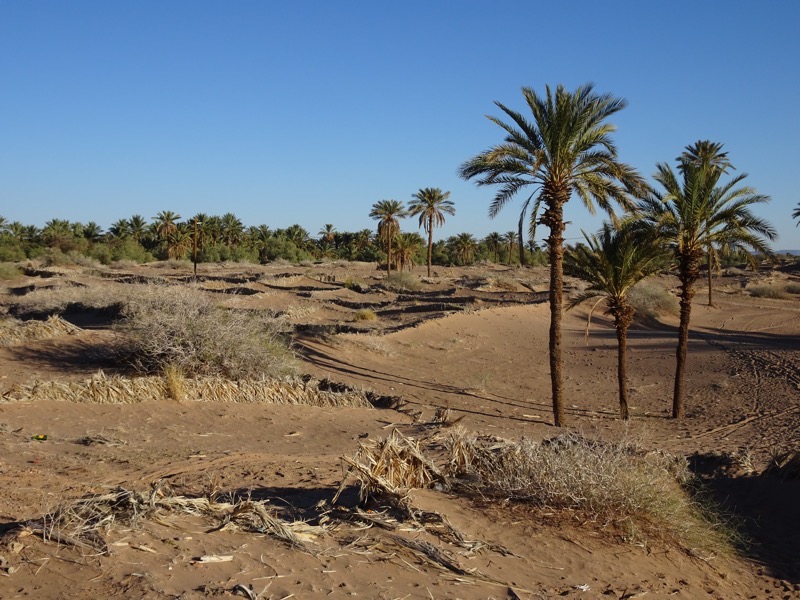 Fresh fencing.
Fresh fencing.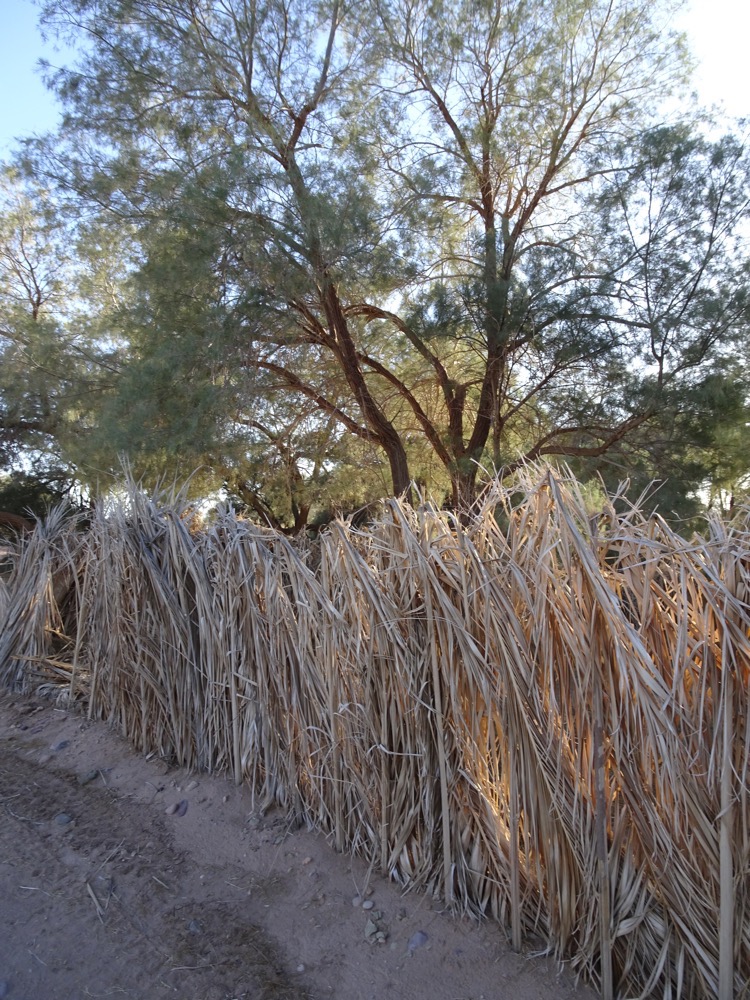
 It was roughly at this point that I got sick of the walk in the sand dunes and lost the energy to look around me properly and keep taking photos – I was in a lot of pain, was trying not to throw up, and working hard on reminding myself to keep breathing. But it’s one of those shitty things – I was kinda committed, and it’s hard to know whether to pull the pin or not, because at this point it could be further to try and walk back the way we came than to keep going to fuck knows where? Additionally, I don’t want to impact the entire group’s walk just because I’m falling apart – some of them might have actually been enjoying this?! Samirr had told us we were going for a ‘gentle walk through the palms’ but here we were up and down small sand dunes and my hips and back were like ‘wtf this doesn’t resemble the brochure’ – I had zero energy for it but had to keep plodding on. Eventually, our walk went ended back at a Riad I recognised called La Soleil du Monde, where I could have waited for the mad bastards that actually wanted to walk 2kms in the sand to see very little more of I know not what? :/
It was roughly at this point that I got sick of the walk in the sand dunes and lost the energy to look around me properly and keep taking photos – I was in a lot of pain, was trying not to throw up, and working hard on reminding myself to keep breathing. But it’s one of those shitty things – I was kinda committed, and it’s hard to know whether to pull the pin or not, because at this point it could be further to try and walk back the way we came than to keep going to fuck knows where? Additionally, I don’t want to impact the entire group’s walk just because I’m falling apart – some of them might have actually been enjoying this?! Samirr had told us we were going for a ‘gentle walk through the palms’ but here we were up and down small sand dunes and my hips and back were like ‘wtf this doesn’t resemble the brochure’ – I had zero energy for it but had to keep plodding on. Eventually, our walk went ended back at a Riad I recognised called La Soleil du Monde, where I could have waited for the mad bastards that actually wanted to walk 2kms in the sand to see very little more of I know not what? :/



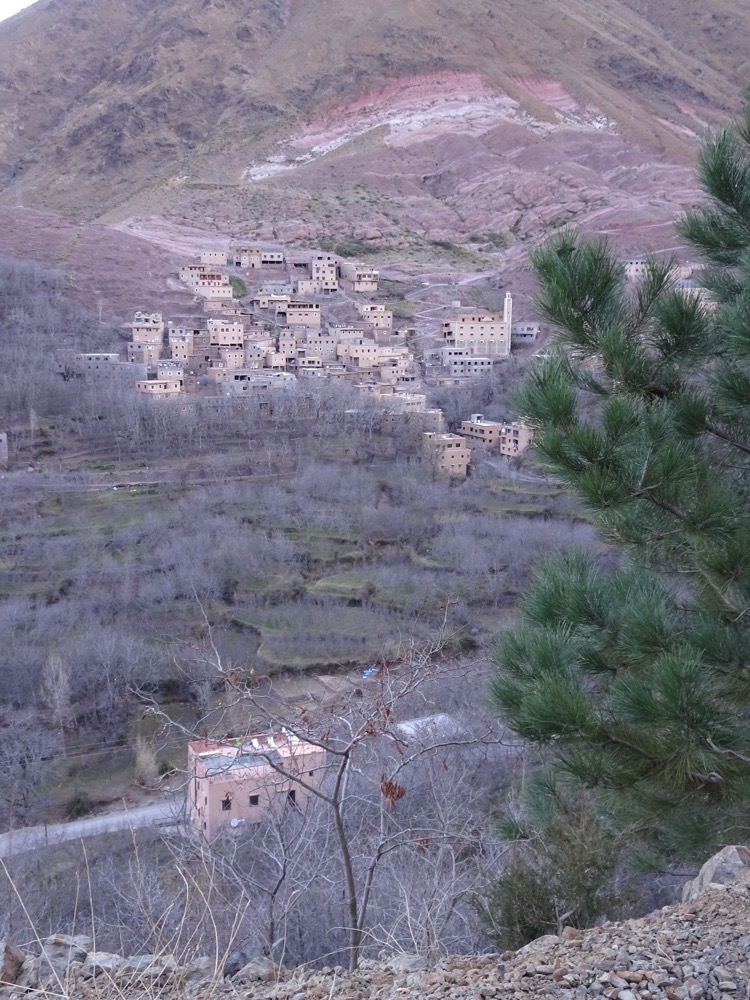 We passed quite a few mules on our way down the road – none of them was Frank.
We passed quite a few mules on our way down the road – none of them was Frank.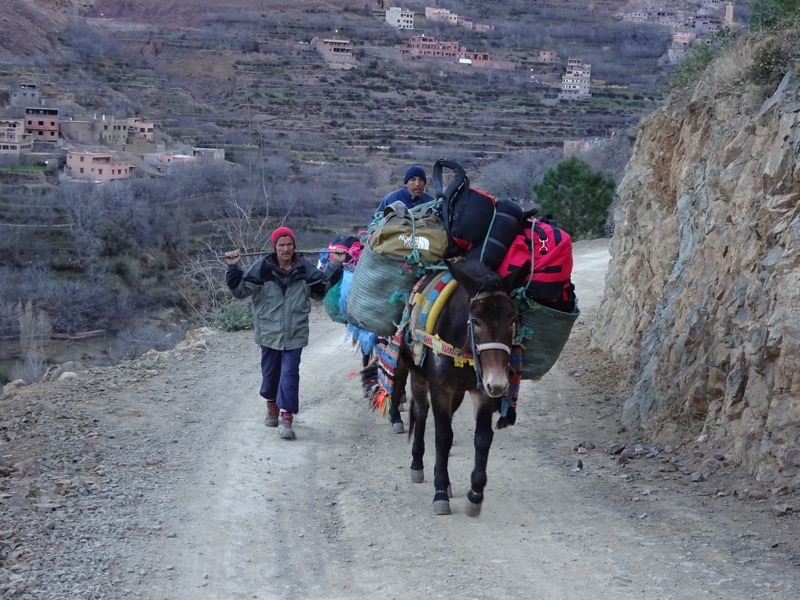
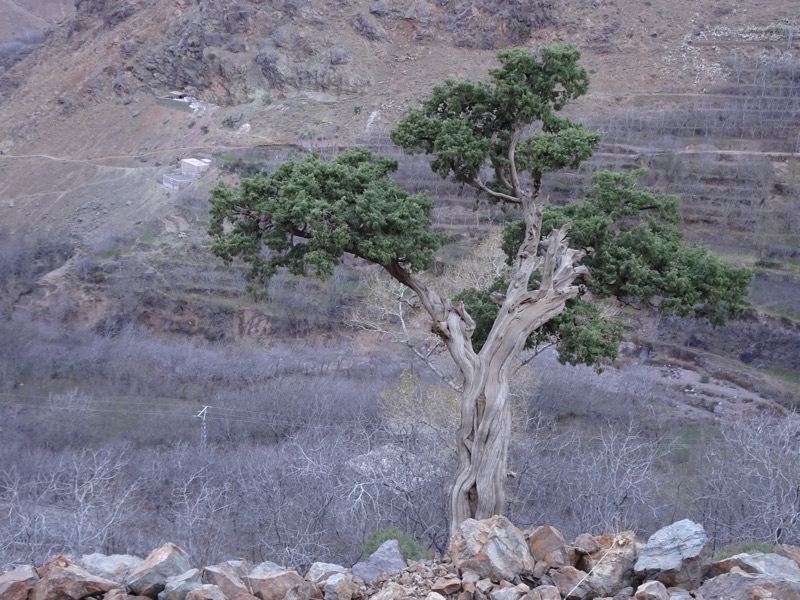 After we returned to Imlil, we collected our larger items of luggage and jumped into the minibus. We had a six hour drive ahead of us and I was not looking forward to it. The landscape was very changeable as we wound along the roads through the High Atlas Mountains.
After we returned to Imlil, we collected our larger items of luggage and jumped into the minibus. We had a six hour drive ahead of us and I was not looking forward to it. The landscape was very changeable as we wound along the roads through the High Atlas Mountains.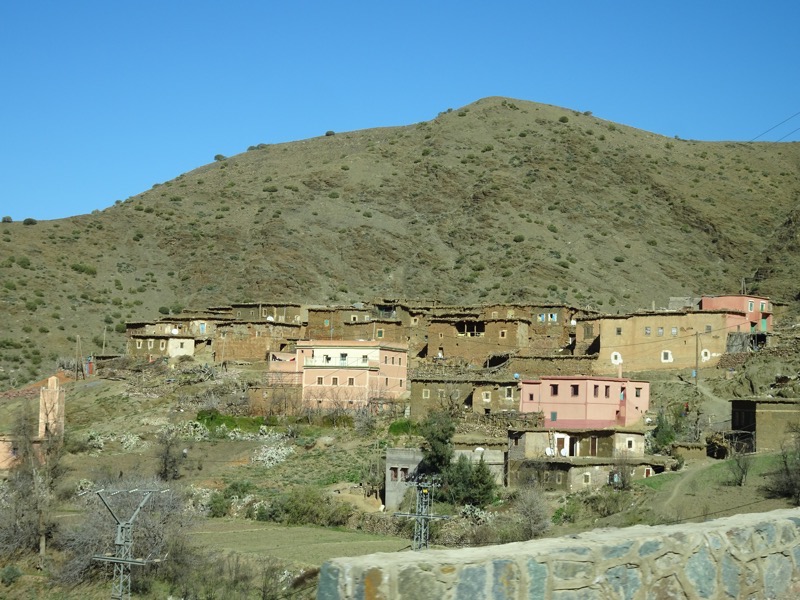
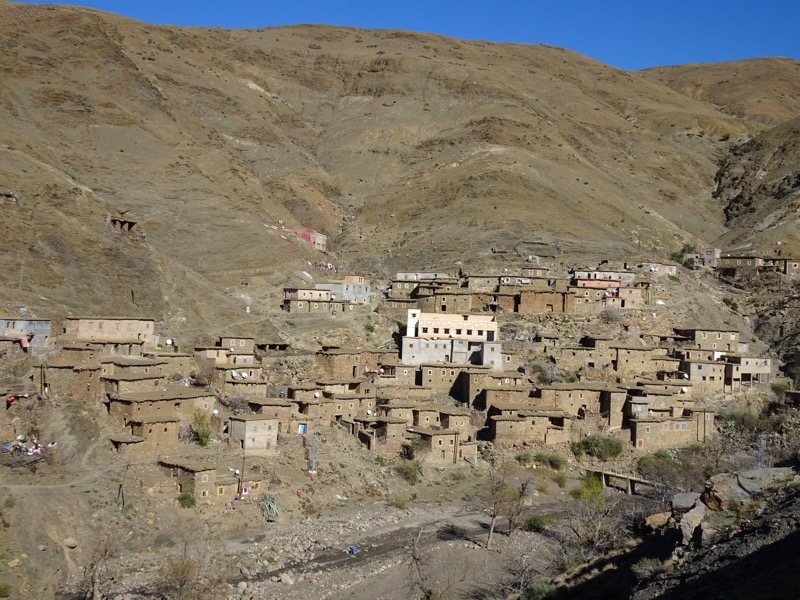 Around 1300, we stopped for a barbeque lunch… there was meat hanging on the street and smoke everywhere with about half a dozen BBQ restaurants all in a row largely catering to truck drivers and tourists.
Around 1300, we stopped for a barbeque lunch… there was meat hanging on the street and smoke everywhere with about half a dozen BBQ restaurants all in a row largely catering to truck drivers and tourists.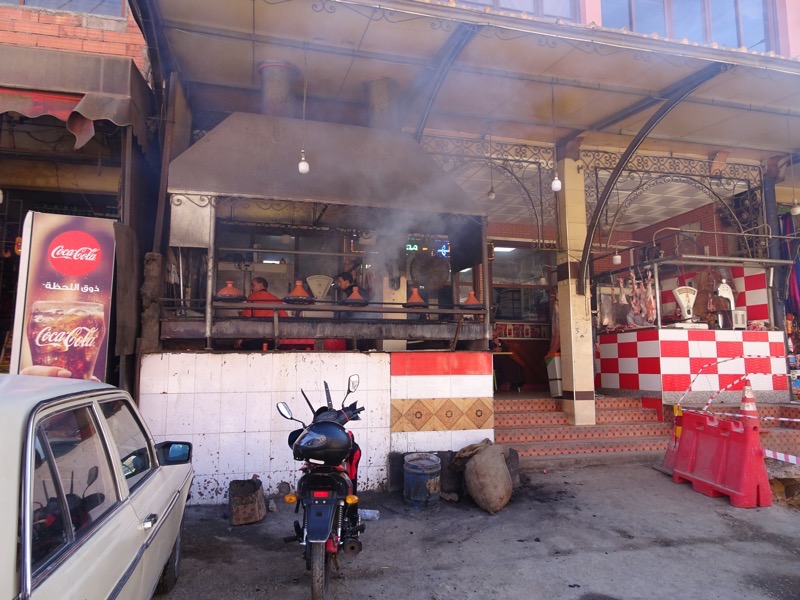 Out the back of the row of restaurants was a small bridge leading to a patio dining area.
Out the back of the row of restaurants was a small bridge leading to a patio dining area.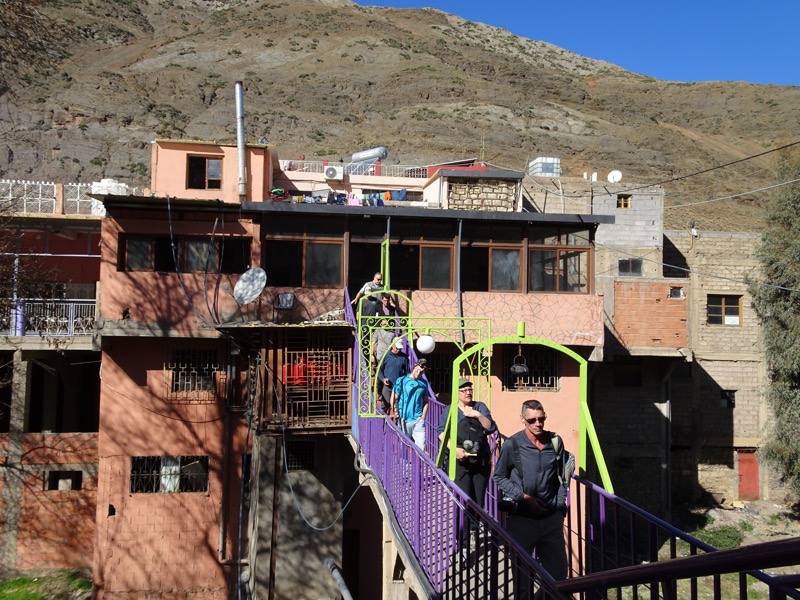 After a meat-heavy meal we hit the road again – the landscape was much more like I expected from Morocco, unlike the north of the country that was so green and lush.
After a meat-heavy meal we hit the road again – the landscape was much more like I expected from Morocco, unlike the north of the country that was so green and lush. Another stop to have a look at a fossil and gemstone store. With no fancy cut stones, or any jewellery to hunt through, the women were largely back on the bus in no time – the men, however, fossicked through the fossils and geodes for quite a while. Several of our party bought a few pieces to take back home.
Another stop to have a look at a fossil and gemstone store. With no fancy cut stones, or any jewellery to hunt through, the women were largely back on the bus in no time – the men, however, fossicked through the fossils and geodes for quite a while. Several of our party bought a few pieces to take back home. A roadside puppy was perched high on a rock overlooking the construction site – a large part of this road was being rebuilt into a proper dual carriageway. Samirr said the contractors in the north were doing a great job, but the contractors in the south were lazy and working with old equipment – we can vouch for that! The ones that were working south of the pass were on machines belching out massive clouds of black smoke. Gross!
A roadside puppy was perched high on a rock overlooking the construction site – a large part of this road was being rebuilt into a proper dual carriageway. Samirr said the contractors in the north were doing a great job, but the contractors in the south were lazy and working with old equipment – we can vouch for that! The ones that were working south of the pass were on machines belching out massive clouds of black smoke. Gross!
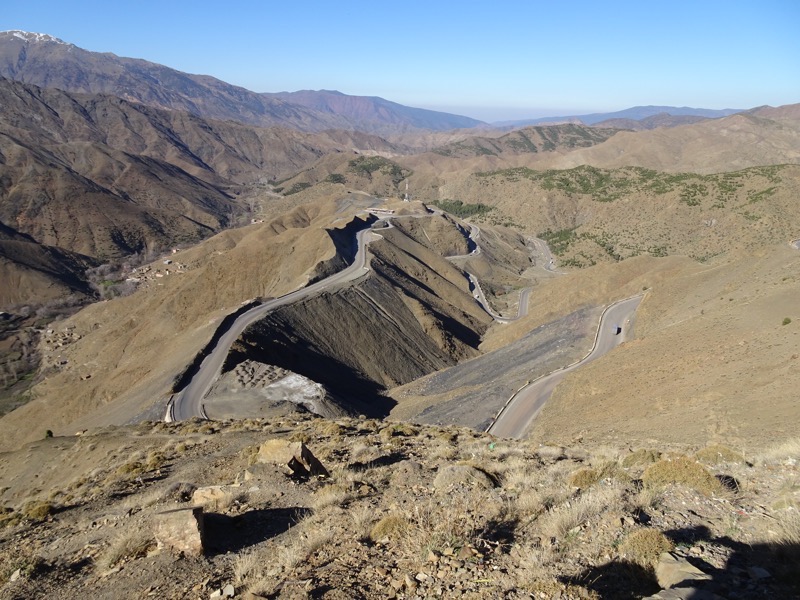 The landscapes were really quite pretty and we had several opportunities for photo stops, and to stretch the legs a bit.
The landscapes were really quite pretty and we had several opportunities for photo stops, and to stretch the legs a bit. These guys had their trinkets set up beside the snow markets… the yellow and red poles are to tell drivers how deep the snow is and to show the edge of the road. By mid-January, these guys won’t be able to hang out here.e
These guys had their trinkets set up beside the snow markets… the yellow and red poles are to tell drivers how deep the snow is and to show the edge of the road. By mid-January, these guys won’t be able to hang out here.e
 After what seemed an interminably long time to be stuck in the bus, we made it to Ait Benhaddou. We walked through the modern side of the town to get to the picturesque ‘movie set’ side of the town.
After what seemed an interminably long time to be stuck in the bus, we made it to Ait Benhaddou. We walked through the modern side of the town to get to the picturesque ‘movie set’ side of the town.
 Aït Benhaddou is a great example of Moroccan earthen clay architecture, it was built in the 17thC and sufferred only a little under French occupation in the early 20thC, so it is incredibly well preserved It was declared a UNESCO World Heritage Site in 1987 and has been a popular place for tourist to visit due to its unique beauty and connection to Hollywood films.
Aït Benhaddou is a great example of Moroccan earthen clay architecture, it was built in the 17thC and sufferred only a little under French occupation in the early 20thC, so it is incredibly well preserved It was declared a UNESCO World Heritage Site in 1987 and has been a popular place for tourist to visit due to its unique beauty and connection to Hollywood films.
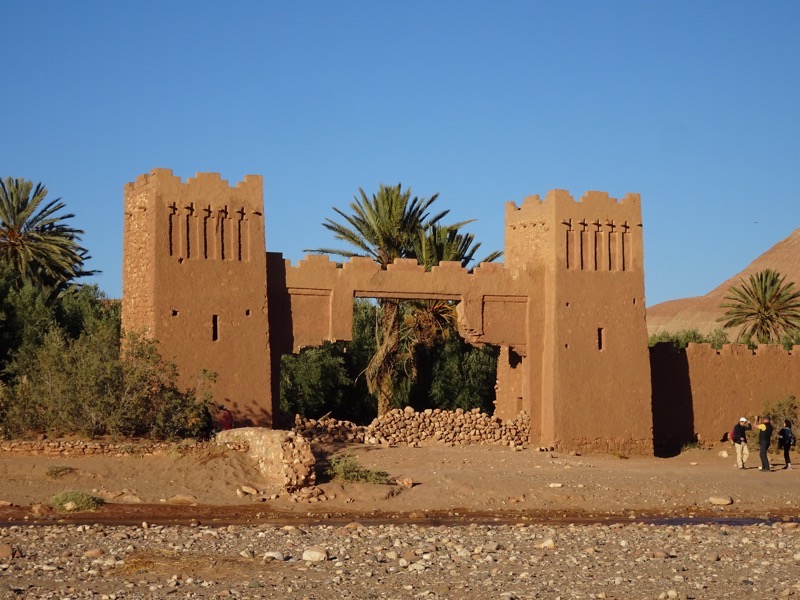

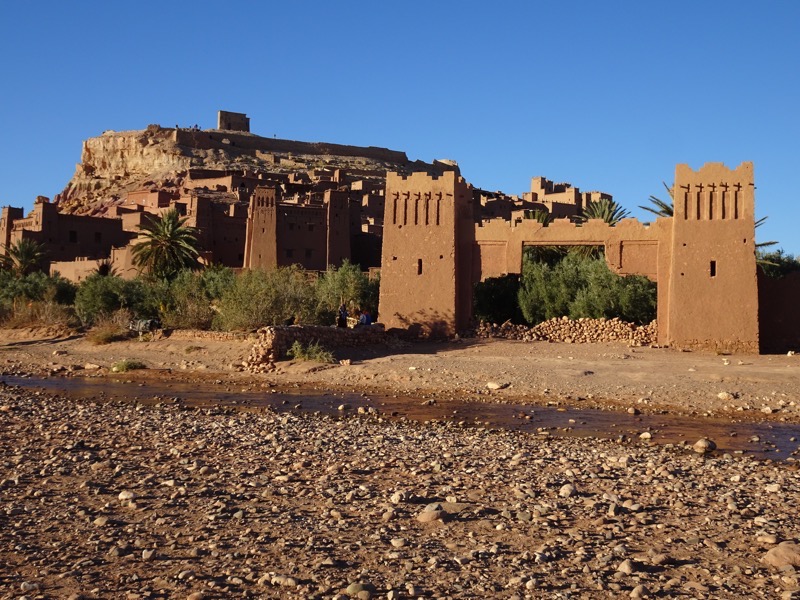 Below is the space used as a slave market and later a fighting arena for the movie, Gladiator.
Below is the space used as a slave market and later a fighting arena for the movie, Gladiator.
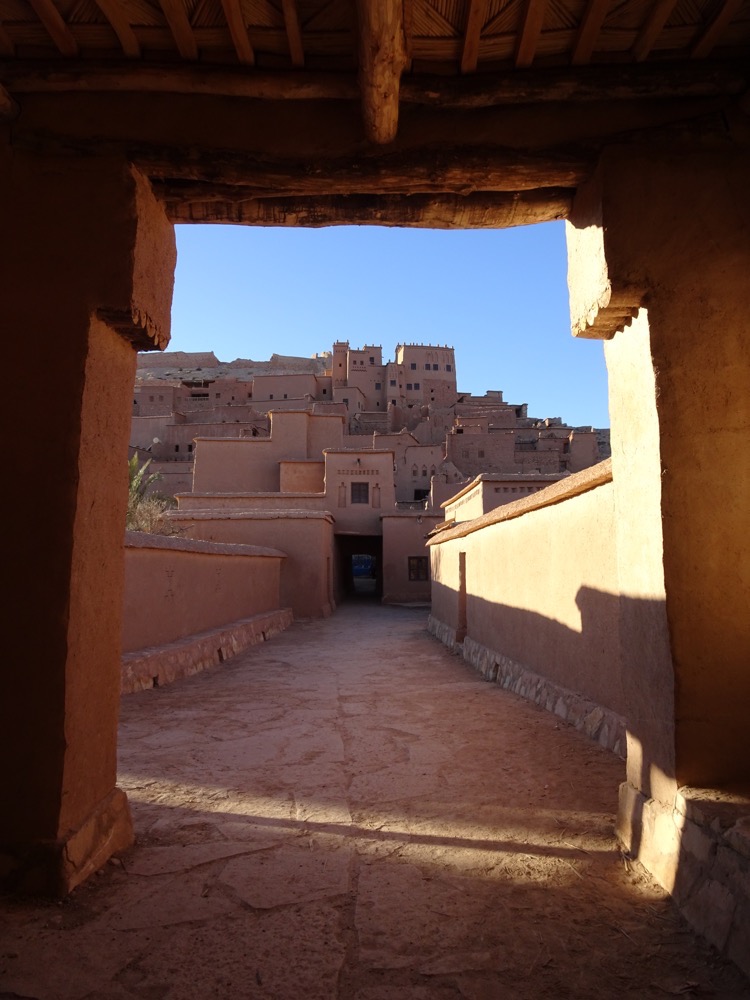 It’s a particularly pretty and very well kept city.
It’s a particularly pretty and very well kept city.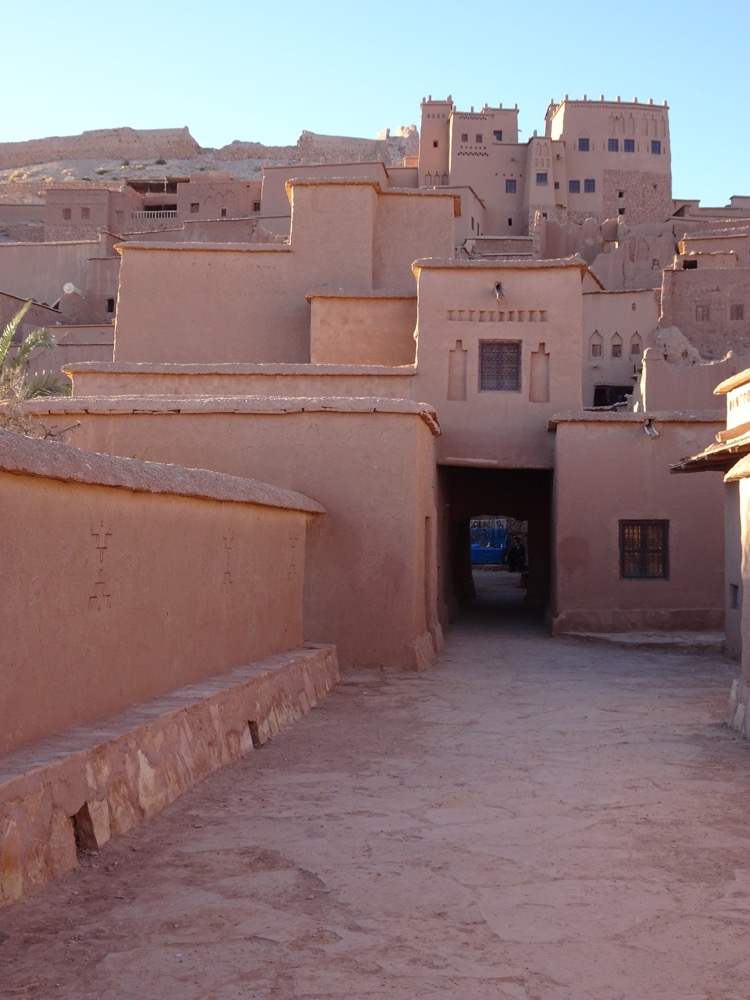
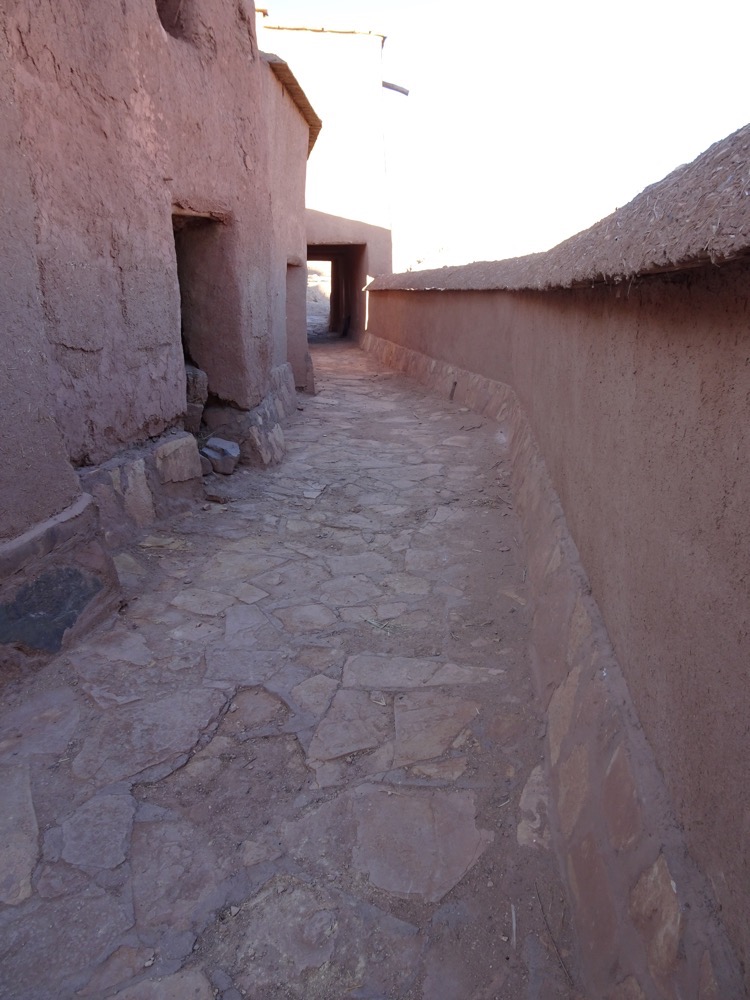
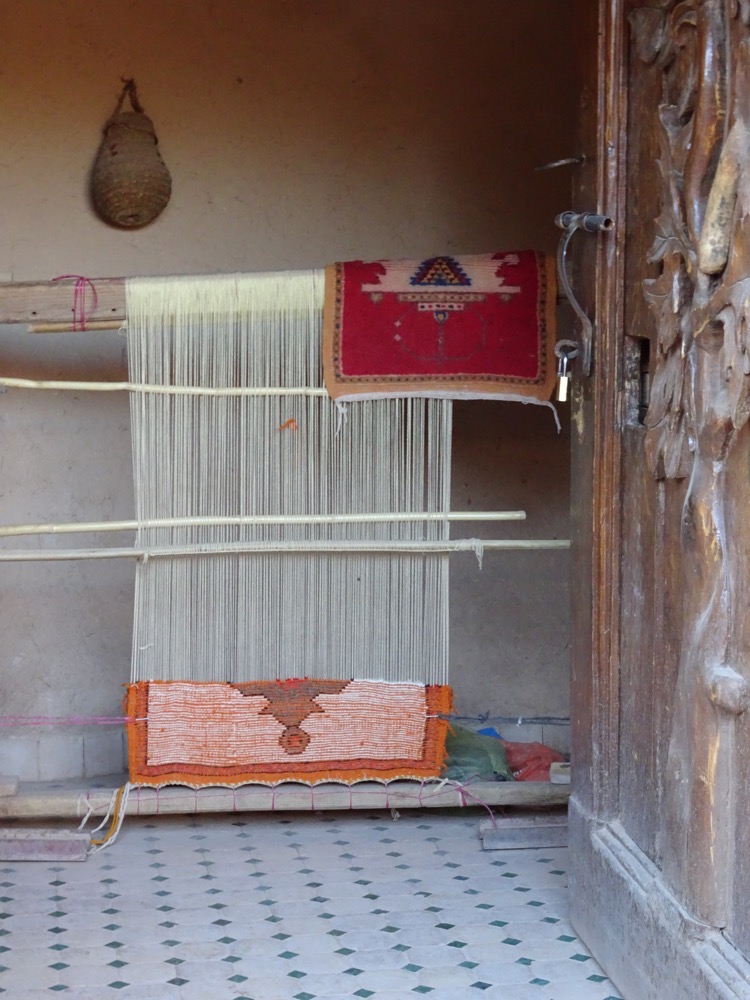 Wandering the streets was interesting – cute little alleyways, and fun little shops. I stupidly made the mistake of pottering around by myself, and had several men trying to lead me into their dark little shops!
Wandering the streets was interesting – cute little alleyways, and fun little shops. I stupidly made the mistake of pottering around by myself, and had several men trying to lead me into their dark little shops! 
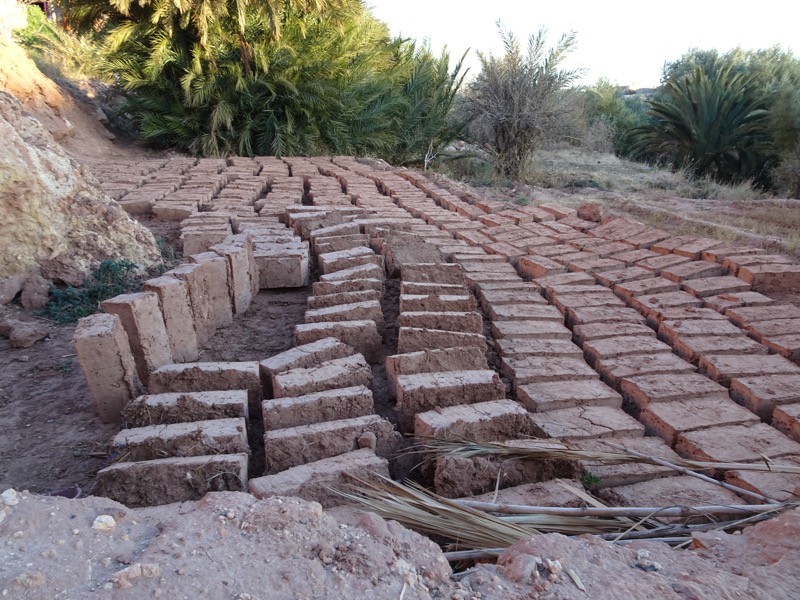
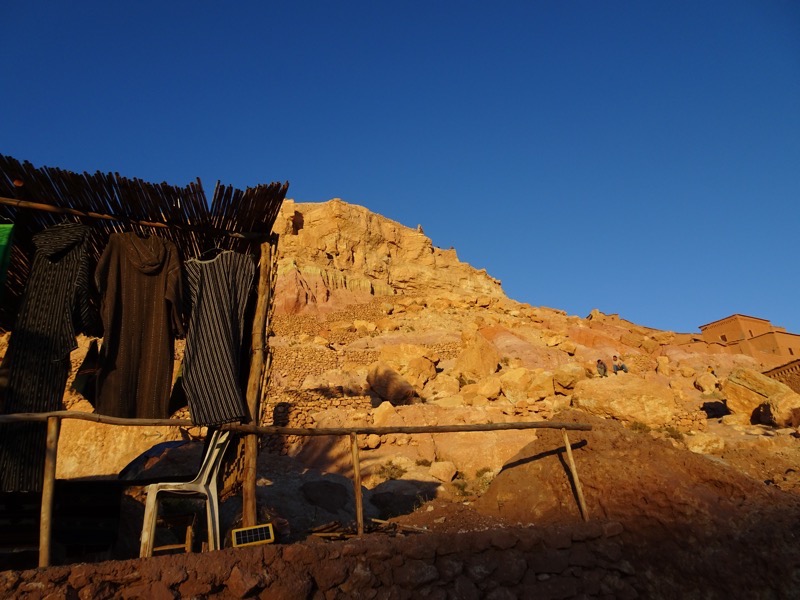
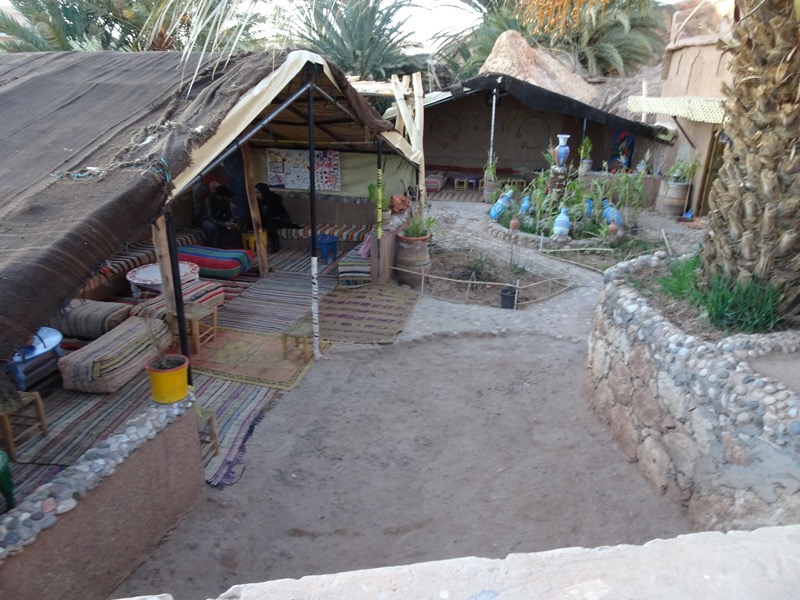 The views from the top of the kasbah:
The views from the top of the kasbah:

 After this, we made our way down to our hotel, where we managed to get ourselves half sorted. We also got to enjoy a cous cous cooking demonstration.
After this, we made our way down to our hotel, where we managed to get ourselves half sorted. We also got to enjoy a cous cous cooking demonstration.
 After this we found ourselves settled into the upstairs terrace to see in the New Year, ther was beer (oh so much beer – thanks to a language communication error with the driver Mohammed who collected supplies for us while we were up at the Berber guest house!) and wine and late night pizza snacks. Everyone had a wonderful night and I slept like a baby for the first night since we arrived in Morocco. Yay for the muscle relaxant effects of alcohol!
After this we found ourselves settled into the upstairs terrace to see in the New Year, ther was beer (oh so much beer – thanks to a language communication error with the driver Mohammed who collected supplies for us while we were up at the Berber guest house!) and wine and late night pizza snacks. Everyone had a wonderful night and I slept like a baby for the first night since we arrived in Morocco. Yay for the muscle relaxant effects of alcohol! Happy New Year from Morocco!
Happy New Year from Morocco!